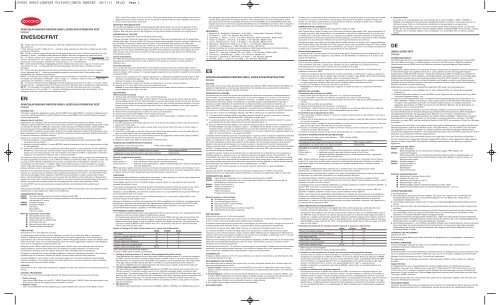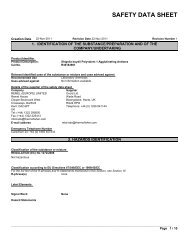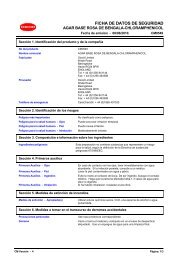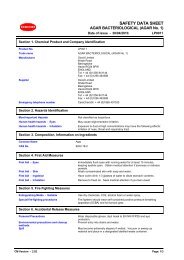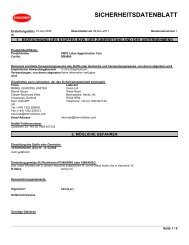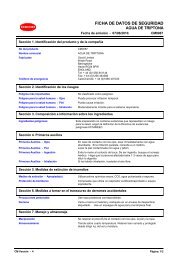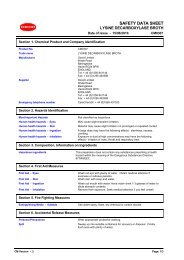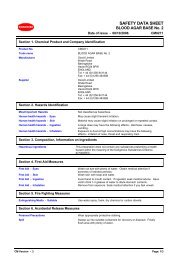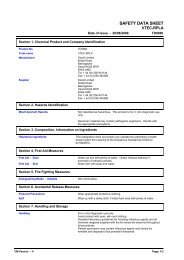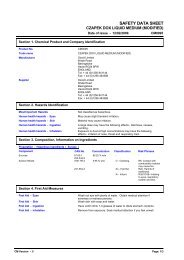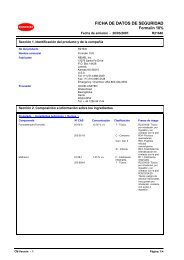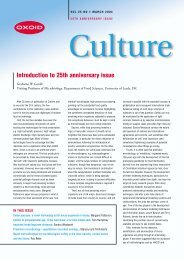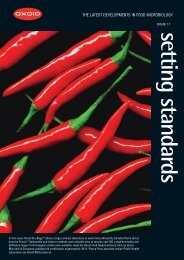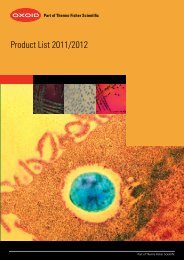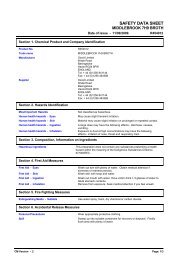104001 OXOID LEAFLET V2:91693_OXOID LEAFLET
104001 OXOID LEAFLET V2:91693_OXOID LEAFLET
104001 OXOID LEAFLET V2:91693_OXOID LEAFLET
Create successful ePaper yourself
Turn your PDF publications into a flip-book with our unique Google optimized e-Paper software.
PENICILLIN-BINDING PROTEIN (PBP2 / ) LATEX AGGLUTINATION TEST<br />
DR0900<br />
EN/ES/DE/FR/IT<br />
CS – Český návod k použití je k dispozici na webových stránkách společnosti Oxoid na adrese<br />
www.oxoid.com.<br />
V části „Návody k použití“ zadejte kód „X“ – podrobné údaje naleznete na štítku láhve. Můžete se též obrátit<br />
na místního distributora.<br />
DA – Der fås en dansk brugervejledning på Oxoids webside www.oxoid.com. I afsnittet ‘Instructions For Use’<br />
indtastes ‘X’-koden – se flaskens etiket vedrørende detaljer. Alternativt kontaktes den lokale distributør.<br />
EL – Οι Οδηγίες χρήσης στην ελληνική γλώσσα διατίθενται στην ιστοσελίδα της Oxoid www.oxoid.com. Στην<br />
ενότητα ‘Instructions For Use’ (Οδηγίες χρήσης), πληκτρολογήστε τον κωδικό ‘X’ – ανατρέξτε στην εξωτερική<br />
συσκευασία για λεπτομέρειες. Εναλλακτικά, επικοινωνήστε με τον τοπικό διανομέα.<br />
NO – Norsk brukerveiledning er tilgjengelig på Oxoids nettsted www.oxoid.com. Legg inn ‘X’-koden under<br />
‘Instructions For Use’ – se flaskeetiketten for flere opplysninger. Alternativt kan du kontakte din locale<br />
forhandler.<br />
PL – Polska instrukcja dostępna jest na stronie internetowej Oxoid www.oxoid.com. W części ‘Instrukcja<br />
użycia’ wprowadź kod ‘X’ – informacje szczegółowe podano na etykiecie butelki. Alternatywnie należy<br />
skontaktować się z lokalnym dystrybutorem.<br />
PT-PT – As Instruções de Utilização estão disponíveis em Português no website da Oxoid em www.oxoid.com.<br />
Na secção das “Instruções de Utilização”, insira o código “X” – consulte o rótulo do frasco para obter mais<br />
informações. Em alternativa, contacte o distribuidor local.<br />
SV – En svensk bruksanvisning är tillgänglig på Oxoids webbplats www.oxoid.com. Skriv in “X”-koden i fältet<br />
“Bruksanvisning” – se flaskans etikett för närmare information. Alternativt kan du kontakta din lokala distributör.<br />
BR-PT – As instruções em português estão disponíveis no site da Oxoid www.oxoid.com. Na seção<br />
‘Instruções de uso’ insira o código ‘X’ – consulte a embalagem externa para obter mais detalhes. Como<br />
alternativa, entre em contato com o seu distribuidor local.<br />
EN<br />
PENICILLIN-BINDING PROTEIN (PBP2 / ) LATEX AGGLUTINATION TEST<br />
DR0900<br />
INTENDED USE<br />
This test is a rapid latex agglutination assay, detecting PBP2 / (also called PBP2a) 7 , in isolates of Staphylococcus,<br />
as an aid in identifying methicillin-resistant Staphylococcus aureus (MRSA) and methicillin-resistant coagulase-<br />
negative staphylococci.<br />
PRINCIPLES OF THE TEST<br />
Staphylococci are a leading cause of nosocomial and community-acquired infections worldwide 2 . In many<br />
institutions, approximately 25% to 50% of S. aureus strains and 75% of coagulase-negative staphylococci (CoNS)<br />
are resistant to methicillin 12 . MRSA are of particular concern because of the ease with which certain epidemic<br />
strains spread and colonise debilitated patients. Treatment of sensitive strains with penicillinase-resistant<br />
penicillins (PRP), is preferred as beta-lactam drugs are more easily absorbed into body fluids and tissues, cause<br />
fewer complications from treatment, and do not select for vancomycin-resistant organisms. Reliable identification<br />
of methicillin-resistance is therefore important.<br />
Strains of S. aureus with reduced susceptibility to PRP are categorised as follows:<br />
iii(i) methicillin-resistant S. aureus (MRSA), which produce the low-affinity penicillin-binding protein PBP2 / ,<br />
encoded by the mecA gene 3,6<br />
ii(ii) borderline methicillin-resistant S. aureus (BORSA), generally considered to be due to hyperproduction of type<br />
A - beta-lactamase 10<br />
(iii) strains with modified PBPs due to altered penicillin-binding capacity or hyper-production of PBPs (MODSA) 1,2 .<br />
MODSA have only rarely been isolated and their clinical response to beta-lactam therapy has not been well<br />
studied. Thus for clinical purposes, with rare exceptions, the presence of PBP2 / is responsible for methicillin-<br />
resistance in the treatment of infections with S. aureus and CoNS 2,6 .<br />
The methicillin-resistant phenotype can be highly heterogeneous, making it difficult to detect by conventional anti-<br />
microbial susceptibility test methods, such as Minimum Inhibitory Concentration (MIC), disc and agar screen. The<br />
accuracy of these methods is affected by inoculum size, incubation time and temperature, medium, pH, salt<br />
concentration and other factors 8,9 . In addition, these culture methods require 24 hours incubation for accurate<br />
results. CoNS often produce lower amounts of PBP2 / and require induction by exposure to one of the PRPs to<br />
produce sufficient product to be detected 2,3,12 .<br />
Detection of the mecA gene has been considered the gold standard in the determination of methicillin-resistance<br />
because of its accuracy, but this method is labour-intensive and expensive to perform 1,6 . The Oxoid PBP2 / Latex<br />
Test has the advantage of direct detection of the PBP2 / protein performed in a rapid timeframe with minimal<br />
labour. It has the potential for being even more accurate than the detection of the mecA gene, as false-positive<br />
results will not occur with strains that possess mecA but are unable to produce the protein product of the gene. In<br />
addition, the assay does not detect strains that are hyperproducers of either beta-lactamase or PBPs.<br />
The Oxoid PBP2 / test has previously been evaluated worldwide, demonstrating its high sensitivity and<br />
specificity 4,5,11 .<br />
Latex particles sensitised with a monoclonal antibody against PBP2 / will specifically react with methicillin-resistant<br />
staphylococci to cause agglutination visible to the unaided eye.<br />
COMPONENTS OF THE KIT<br />
DR0901 Test Latex sensitised with a monoclonal antibody against PBP2 /<br />
DR0902 Control Latex sensitised with a monoclonal antibody of the same lgG subclass showing no reactivity<br />
with proteins of S. aureus<br />
DR0903 Extraction Reagent 1<br />
DR0904 Extraction Reagent 2<br />
Test Cards<br />
Mixing Sticks<br />
Instruction Leaflet<br />
Materials required but not provided<br />
● Micropipette and tips (50µl)<br />
● Microbiological loops (5µl/1µl)<br />
● Boiling water bath or heating block<br />
● Centrifuge (1500 x g)<br />
● Microcentrifuge tubes (safe lock)<br />
● Suitable laboratory disinfectant<br />
PRECAUTIONS<br />
This product is for in vitro diagnostic use only.<br />
The heating time should be three minutes. Heating for more than five minutes may lead to a decrease in<br />
sensitivity. Heating for only one minute or less may lead to non-specific agglutination. When removing the<br />
supernatant for use in the test following centrifugation, withdraw the pipette carefully to avoid solid material at the<br />
bottom of the tube. Carry over of solid material may cause non-specific agglutination. Shake the Latex Reagents<br />
well to form a homogeneous suspension before use.<br />
Reagents contain 0.095% sodium azide as a preservative. Sodium azide is toxic and may react with lead or<br />
copper plumbing to produce metal azides which are explosive by contact detonation. To prevent azide<br />
accumulation in plumbing, flush with copious amounts of water immediately after waste disposal.<br />
As specimen materials may contain pathogenic organisms, handle with appropriate precautions. The extraction<br />
procedure may not kill bacteria; therefore the extract must be handled with the same precautions.<br />
Extraction Reagents 1 and 2 contain a mild irritant and a weak acid. Avoid direct contact by wearing suitable<br />
protective equipment. If the material comes into contact with the skin, mucous membranes or eyes immediately<br />
wash the area by rinsing with plenty of water.<br />
STORAGE<br />
Store the kit at 2-8°C. Under these conditions the reagents will retain their reactivity until the expiry date shown on<br />
the box.<br />
CONTROL PROCEDURES<br />
For each new lot of the kit and weekly thereafter, the following control procedures must be performed.<br />
1. Positive Control<br />
Use a known MRSA strain such as ATCC ® 43300 (Oxoid Culti-Loops ® CL9022). Follow the method given in the<br />
test procedure. Ensure that agglutination occurs within 3 minutes.<br />
2. Negative Control<br />
Use a known Methicillin-Sensitive Staphylococcus aureus (MSSA) strain such as ATCC ® 25923 or ATCC ®<br />
29213, (Oxoid Culti-Loops ® CL7010 or CL7011). Follow the method given in the test procedure. Ensure that no<br />
agglutination occurs within 3 minutes. Do not use the test if reactions with the control organisms are incorrect.<br />
3. Do not use kits beyond their expiry date.<br />
IMPORTANT PROCEDURE NOTE<br />
Do not allow the reagents to become contaminated by allowing the dropper tip to touch the specimen on the<br />
reaction card. Ensure that the caps are securely fitted after use to prevent contamination and drying out of the<br />
reagents. After use return the kit to the refrigerator ensuring that the bottles are stored in an upright position.<br />
PREPARATION OF CULTURE<br />
Colonies may be tested from any of the following culture media:<br />
Tryptone Soya Agar (Tryptic Soy Agar) with 5% sheep blood (TSA blood), Columbia Agar with 5% sheep blood,<br />
Mueller-Hinton Agar. The use of fresh (18-24 hours) cultures is recommended. However, cultures 24-48 hours old<br />
may be tested, if necessary to obtain sufficient growth. The performance data quoted in this leaflet were<br />
generated using these media as part of the submission to the North American Food and Drugs Administration.<br />
Data on file show that the test is also effective with colonies of S. aureus from Tryptone Soya Agar and Columbia<br />
Agar with 5% horse blood, Iso-Sensitest Agar and DSTA. These media are commonly used in Europe but not in<br />
North America, and so they were not used in the trials used to generate the data shown in the Performance<br />
Characteristics section.<br />
Special requirements:<br />
The PBP2 / test should be performed only on Staphylococcus species (Gram-positive cocci). A coagulase or<br />
equivalent test must be performed in order to determine if the isolate is S. aureus or another species of<br />
Staphylococcus.<br />
Inoculum preparation:<br />
For S. aureus, the test can be performed from well-isolated colonies on the primary isolation plate, if there is<br />
sufficient growth, or from a subculture of the isolate. Other microbiota that are present on the plate have not been<br />
shown to interfere with the assay. For coagulase-negative staphylococci, an induction is needed for the production<br />
of sufficient PBP2 / .<br />
1. Prepare a broth suspension of the organism equivalent to a 1 McFarland standard and streak a lawn on TSA<br />
with blood, Columbia Blood Agar, or Mueller-Hinton Agar. Alternatively, inoculate the agar plate with several<br />
colonies and streak in four quadrants.<br />
2. Place an oxacillin disc (1µg/ml) onto the lawn of organisms or in the main inoculum quadrant.<br />
3. Incubate at 37°C for at least 24 hours but not more than 48 hours.<br />
Caution: To avoid false negative results,do not perform the test unless sufficient inoculum is available. Always<br />
harvest organisms from close to the disc.<br />
TEST METHOD<br />
PBP2 / Extraction Procedure<br />
1. Add four drops of Extraction Reagent 1 into a microcentrifuge tube.<br />
2. Approximately 1.5 x 10 9 (3-5µl) cells should be tested. This may be achieved by using a sterile 5µl loop to<br />
remove sufficient growth to fill the internal diameter of the loop. Alternatively, a sterile 1µl loop may be used to<br />
remove several colonies and scoop up a heaped loopful 1mm high covering the external diameter of the loop.<br />
Suspend the test culture in the microcentrifuge tube. Vortex, if clumps are present. A very turbid suspension<br />
should be visible.<br />
3. Place the tube into boiling water or heating block (OVER 95°C) and heat for three minutes.<br />
4. Remove the microcentrifuge tube and allow it to cool to room temperature.<br />
5. Add one drop of Extraction Reagent 2 into the tube and mix well.<br />
6. Centrifuge at 1500 x g for five minutes, (i.e., 3000rpm at 15cm rotation radius or 4500rpm at 4.5cm rotation<br />
radius). Use the supernatant for the test.<br />
Latex Agglutination Procedure<br />
1. For each supernatant to be tested, label one circle of the test card for testing with Test Latex and another for<br />
testing with Control Latex.<br />
2. Mix the Latex reagents well by inversion several times, and add one drop of Test Latex or Control Latex to<br />
each labelled circle.<br />
3. Place 50µl of supernatant on the Test circle and the Control circle, being careful to avoid the pellet. Mix the<br />
latex and supernatant in each circle thoroughly with a mixing stick.<br />
4. Pick up and rock the card for up to three minutes and look for agglutination under normal lighting conditions.<br />
Record the results of the test and control reactions.<br />
5. Dispose of reaction card safely into disinfectant or infectious waste.<br />
READING AND INTERPRETATION OF RESULTS<br />
Agglutination is seen with Test but not PBP2 / Positive (MRSA)<br />
Control Latex within 3 minutes<br />
No agglutination in either Latex Reagent within 3 minutes PBP2 / Negative (MSSA)<br />
Agglutination is seen with the Control Latex within 3 minutes Indeterminate<br />
Strength of agglutination reaction<br />
Negative (–) = a homogeneous suspension of particles with no visible clumping<br />
Weak positive (+) = small but definite clumps against a clouded background<br />
Strong positive (+) = large and small clumps against a slightly clouded background or large clumps against a<br />
very clear background.<br />
NB Occasionally, negative reactions may have a finely granular appearance or reactions can be stringy. In such<br />
cases, the degree of background clearing should be used to interpret the result. An opaque background indicates<br />
a negative result and a clear background should be interpreted as a positive result.<br />
LIMITATIONS<br />
Indeterminate results should be re-tested with a fresh extract. If, upon retesting, the result is again indeterminate,<br />
the methicillin resistance must be determined by other methods.<br />
False-negative results can occur if insufficient culture is used for testing. In such cases, the test should be<br />
repeated with sufficient culture.<br />
True positive results generally have strong reactions. False-positive reactions have been known to occur rarely,<br />
but are generally limited to weak reactions. Such results can be verified by retesting with a fresh culture.<br />
Modified S. aureus (MODSA), and borderline resistant strains of S. aureus (BORSA) do not possess PBP2 / and<br />
are not expected to react in this assay.<br />
Some organism strains may have a low level methicillin-resistance or, in rare cases, produce PBP2 / in low<br />
amounts, and give a false negative result.<br />
Because of limitations in sensitivity and specificity of the CLSI susceptibility test methods for coagulase-negative<br />
staphylococci 9 , particularly for strains other than Staphylococcus epidermidis, the results with the PBP2 / assay<br />
may not agree with the results of standard susceptibility testing. Strains with MICs of ≥0.5µg/ml should be<br />
considered methicillin-resistant, regardless of the PBP2 / assay results.<br />
PERFORMANCE CHARACTERISTICS<br />
1. The Oxoid Penicillin-Binding Protein Latex Agglutination Test has been evaluated in four geographically diverse<br />
laboratories with fresh clinical isolates of Staphylococcus aureus.<br />
201 isolates were tested with NCCLS methods and with the Oxoid PBP2 / test from each of three media. One<br />
weak false-positive Oxoid Latex reaction (negative on repeat) was found from TSA with blood. All positive<br />
reactions were strong, except 3 weak (but positive) reactions from Mueller-Hinton Agar. The sensitivity of the<br />
Latex test in detecting MRSA on each medium was 100%; the specificity was 99% for TSA with blood and<br />
100% for tests from all other media.<br />
Results of testing of 201 fresh clinical isolates of S. aureus from 4 laboratories:<br />
MRSA BORSA A MSSA<br />
No. tested 68 3 130<br />
Growth on Oxacillin Salt Agar (NCCLS) 68 0 0<br />
MIC ≥4µg/ml (NCCLS) 68 0 0<br />
Positive Latex from TSA Blood 68 0 1 (1) B<br />
Positive Latex from Columbia Blood 68 0 0<br />
Positive Latex from Mueller-Hinton 68 (3) B 0 0<br />
A MICs were 2µg/ml and mecA was negative.<br />
B Number of weak reactions shown in parentheses.<br />
2. Testing of challenge strains of S. aureus in three geographically distinct areas:<br />
Three laboratories each examined a set of previously collected challenge strains of S. aureus and compared<br />
the PBP2 / results to the NCCLS methods of determination of MRSA. A total of 724 strains were tested from<br />
TSA with blood. The sensitivity of the Oxoid PBP2 / test was 98.5% and the specificity was 100%. Sensitivities<br />
of the agar screen and MIC methods were 98.7% and 99.2% and specificities were 90.0% and 88.7%.<br />
Two strains of MODSA were also tested separately; both strains gave a negative result with the Latex test.<br />
3. Testing Coagulase-negative staphylococci<br />
Two laboratories tested coagulase-negative staphylococci for PBP2 / after induction with oxacillin discs. One<br />
laboratory tested 115 methicillin-resistant strains and 45 methicillin-susceptible strains, including 58 fresh<br />
clinical isolates. The sensitivity was 96.5% for testing from TSA blood and 95.6% for Mueller-Hinton Agar. The<br />
specificity was 100% from TSA blood and 98% from Mueller-Hinton Agar. Obtaining a good inoculum was more<br />
difficult with Mueller-Hinton Agar. The second laboratory tested 212 methicillin-resistant strains and 203<br />
methicillin-susceptible strains with a sensitivity of 99.5% and specificity of 99.5%, using growth on Columbia<br />
Agar for the inoculum.<br />
4. Reproducibility<br />
Ten different well-characterised S. aureus strains (3 MRSA, 3 MSSA, 3 BORSA and 1 MODSA) were sent to<br />
three geographically diverse laboratories with each strain submitted 5 times in a coded and blinded fashion. All<br />
150 test results agreed with the expected results for 100% reproducibility. The three mecA positive strains<br />
were positive each time they were tested (45/45 tests). The three MSSA and the three BORSA strains gave<br />
negative results each time the test was performed (90/90 tests). The MODSA strains had an MIC of 16µg/ml to<br />
oxacillin and gave a negative result in the Oxoid Latex Test, as expected, each time the test was performed<br />
(15/15 tests).<br />
REFERENCES<br />
1. Bignardi G.E., Woodford N., Chapman A., et al (1996). J. Antimicrobiol. Chemother., 37:53-63.<br />
2. Chambers H.F., (1997). Clin. Microbiol. Rev., 10:781-791.<br />
3. Gerberding J.L., Miick C., Liu H.H., et al (1991). Antimicrob. Agents Chemother., 35:2574-2579.<br />
4. Hussain Z., Stoakes L., Garrow S., et al (2000). J. Clin. Microbiol., 38:2051-2054.<br />
5. Louie L., Matsumura S.O., Choi E., et al (2000). J. Clin. Microbiol., 38:2170-2173.<br />
6. Murakami K., Minamide W., Wada K., et al (1991). J. Clin. Microbiol., 29:2240-2244.<br />
7. Nakatomi Y., and Sugiyama J., (1998). Microbiol. Immunol., 42:739-743.<br />
8. National Committee for Clinical Laboratory Standards. (2000 Approved Standard Fifth Edition (M7-A5)).<br />
National Committee for Clinical Laboratory Standards, Wayne, Pa.<br />
9. Tenover F.C., Jones R.N., Swenson J.M., et al (1999). J. Clin. Microbiol., 37:4051-4058.<br />
10. Thornsbury C. and McDougal L. (1983). J. Clin. Microbiol., 18:1084-1091.<br />
11. Yamazumi T., Marshall S.A., Wilke W.W., et al (2001). J. Clin. Microbiol., 39:53-56.<br />
12. York M.K., Gibbs L., Chehab F., et al (1996). J. Clin. Microbiol., 34:249-253.<br />
ES<br />
PENICILLIN-BINDING PROTEIN (PBP2 / ) LATEX AGGLUTINATION TEST<br />
DR0900<br />
UTILIDAD<br />
Esta prueba es un ensayo rápido de aglutinación de látex para detectar PBP2 / (también denominada PBP2a) 7 en<br />
aislados de Staphylococcus, diseñado para la identificación de Staphylococcus aureus meticilín-resistentes y<br />
estafilococos coagulasa-negativos meticilín-resistentes.<br />
PRINCIPIOS DE LA PRUEBA<br />
Los estafilococos son una de las causas más frecuentes de infecciones nosocomiales y extrahospitalarias en<br />
todo el mundo 2 . En muchos hospitales, entre el 25 y el 50% de los aislados de S. aureus y el 75% de los de<br />
estafilococos coagulasa-negativos, son resistentes a meticilina 12 . Los MRSA suponen un problema sanitario<br />
especialmente importante, debido a la facilidad con la que determinadas razas epidémicas se extienden y<br />
colonizan pacientes debilitados. El tratamiento de los aislados sensibles con penicilinas resistentes a la<br />
penicilinasa (PRP) es de elección, puesto que los antibióticos betalactámicos tienen una buena distribución a los<br />
tejidos, producen menos complicaciones terapéuticas y no seleccionan microorganismos resistentes a<br />
vancomicina. La identificación correcta y fiable de la resistencia a meticilina es, por tanto, de capital importancia.<br />
Las razas de S. aureus con sensibilidad reducida a las PRP se clasifican en las siguientes categorías:<br />
ii(i) S. aureus meticilín-resistente (MRSA, del inglés methicillin-resistant S. aureus), que produce la proteína<br />
fijadora de penicilina de baja afinidad PBP2 / , codificada por el gen mecA 3,6<br />
i(ii) S. aureus de resistencia incierta a meticilina (BORSA, del inglés borderline methicillin-resistant S. aureus),<br />
que habitualmente se debe a hiperproducción de beta-lactamasa tipo A 10 , y<br />
(iii) razas con PBPs modificadas debido a una capacidad alterada de fijación de la penicilina o a hiperproducción<br />
de PBPs (MODSA, del inglés modified S. aureus) 1,2 . Los MODSA se han aislado en raras ocasiones y su<br />
respuesta clínica a la terapia con betalactámicos no ha sido bien estudiada. Por tanto, a efectos clínicos, la<br />
resistencia a meticilina en el tratamiento de infecciones por S. aureus o estafilococos coagulasa-negativos se<br />
debe, con raras excepciones, a la presencia de PBP2 / .<br />
El fenotipo meticilín-resistente puede ser muy heterogéneo, lo que hace difícil su detección mediante los métodos<br />
convencionales de estudio de la sensibilidad antimicrobiana, tales como la Concentración Inhibidora Mínima<br />
(CIM), o los métodos de criba en agar o con disco. La exactitud de estos métodos se ve afectada por la densidad<br />
del inóculo, temperatura y tiempo de incubación, medio utilizado, pH, concentración de sales y otros factores 8,9 .<br />
Además, todos estos métodos basados en el cultivo necesitan un periodo de 24 horas de incubación para<br />
obtener resultados fiables. Los estafilococos coagulasa-negativos producen con frecuencia concentraciones bajas<br />
de PBP2 / y pueden necesitar de una inducción por exposición a una de las PRPs, para producir una cantidad<br />
suficiente que pueda ser detectada 2,3,12 .<br />
La detección del gen mecA se ha considerado como el “gold standard” en la determinación de la resistencia a<br />
meticilina, debido a su exactitud, pero es un método de realización compleja y de alto coste económico 1,6 . El<br />
“Oxoid PBP2 / Latex Test” tiene la ventaja de la detección directa de la PBP2 / , de manera rápida y con un trabajo<br />
mínimo. Puede ser incluso más exacta que la detección del gen mecA, puesto que no dará resultados positivos<br />
en aquellos aislados que poseen el gen pero que no producen la proteina. Además, no detecta aquellos aislados<br />
que simplemente sean hiperproductores ya sea de betalactamasa, o de PBPS.<br />
El “Oxoid PBP2 / Test” ha sido evaluado a nivel mundial, habiendo demostrado una gran sensibilidad y<br />
especificidad 4,5,11 .<br />
Las partículas de látex sensibilizadas con una anticuerpo monoclonal contra la PBP2 / , reaccionarán<br />
especificamente con los estafilococos meticilín-resistentes y producirán una aglutinación visible a simple vista.<br />
COMPONENTES DEL EQUIPO<br />
DR0901 Látex Reactivo sensibilizado con un anticuerpo monoclonal contra la PBP2 /<br />
DR0902 Látex de control sensibilizado con un anticuerpo monoclonal de la misma subclase de IgG sin<br />
reactividad con proteínas de S. aureus<br />
DR0903 Reactivo de Extracción 1<br />
DR0904 Reactivo de Extracción 2<br />
Tarjetas de Reacción<br />
Palitos mezcladores<br />
Prospecto de instrucciones<br />
Material necesario no suministrado<br />
● Micropipeta y puntas (50µl)<br />
● Asas microbiológicas (5µl/1ul)<br />
● Baño de ebullición o bloque térmico<br />
● Centrífuga (1500 x G)<br />
● Tubos de microcentrífuga (con cierre de seguridad)<br />
● Desinfectante de laboratorio adecuado.<br />
PRECAUCIONES<br />
Este producto es para uso in vitro exclusivamente.<br />
El tiempo de calentamiento debe ser de tres minutos. Por encima de cinco minutos disminuye la sensibilidad. Si<br />
es de un minuto o menos se pueden producir aglutinaciones inespecíficas.<br />
Al recoger el sobrenadante para la prueba tras la centrifugación, se debe evitar aspirar o recoger con la punta de<br />
la pipeta material sólido del fondo del tubo, ya que éste podría producir aglutinaciones inespecíficas.<br />
Los reactivos de látex se deben agitar hasta conseguir una suspensión homogénea antes de su uso.<br />
Los reactivos contienen un 0,095% de azida sódica como conservante. La azida sódica es tóxica y puede<br />
reaccionar con las cañerías de plomo o cobre y producir azidas metálicas que son explosivas por detonación de<br />
contacto. Para evitar la acumulación de azidas en las cañerías de los desagües, se debe dejar correr un volumen<br />
abundante de agua tras el vertido del material de desecho.<br />
Puesto que las muestras pueden contener microorganismos patógenos, se deben manipular con las precauciones<br />
adecuadas. El procedimiento de extracción puede no matar a las bacterias y, por tanto, el extracto se debe<br />
manipular con las mismas precauciones.<br />
Los Reactivos de Extracción 1 y 2 contienen un irritante ligero y un ácido débil. Se debe evitar el contacto directo<br />
mediante el uso del equipo protector adecuado. Si se produce un contacto con la piel, membranas mucosas u<br />
ojos se debe lavar inmediatamente el área afectada con agua corriente abundante.<br />
CONSERVACIÓN<br />
El equipo se debe conservar a 2-8°C. En esas condiciones, los reactivos mantendrán su actividad hasta la fecha<br />
de caducidad indicada en la caja.<br />
PROCEDIMIENTOS DE CONTROL<br />
Para cada equipo que se empiece de un nuevo lote y una vez a la semana mientras dure, se deben seguir los<br />
siguientes procedimientos de control.<br />
1. Control Positivo: utilícese una raza conocida de MRSA, como la ATCC ® 43300 (Oxoid Culti-Loop CL9022).<br />
Sígase el método indicado en el prospecto de instrucciones. La aglutinación se debe producir en un plazo de<br />
tres minutos.<br />
2. Control Negativo: utilícese una raza conocida de Staphylococcus aureus sensible a meticilina (MSSA), como<br />
la ATCC ® 25923 (Oxoid Culti-Loop CL7010). Sígase el método indicado en el prospecto de instrucciones. No<br />
se debe producir aglutinación en un plazo de tres minutos. Si las reacciones obtenidas con los<br />
microorganismos de control no son correctas, el equipo no debe utilizarse.<br />
3. No se debe utilizar el equipo más allá de la fecha de caducidad.<br />
NOTA IMPORTANTE<br />
Se debe evitar la contaminación de los reactivos por contacto de la punta del gotero con la muestra en la tarjeta<br />
de reacción. Una vez se ha terminado de usar el equipo, los tapones de los goteros se deben recolocar con<br />
firmeza, a fin de evitar la contaminación y el resecado de los reactivos. El equipo se debe volver a refrigerar<br />
inmediatamente, con los viales en posición vertical.<br />
PREPARACIÓN DE LA MUESTRA<br />
Se puede analizar colonias obtenidas de los siguientes medios de cultivo:<br />
Agar Tryptone Soya (Tryptic Soy Agar) con 5% de sangre de carnero (Agar sangre TSA), Agar columbia con 5%<br />
de sangre de carnero, Agar Mueller-Hinton. Se recomienda la utilización de cultivos frescos (18-24 horas), pero<br />
se puede utilizar cultivos de 24-48 horas, si es necesario para obtener crecimiento suficiente. Los datos de las<br />
características de funcionamiento que aparecen en este prospecto, se obtuvieron utilizando los medios indicados,<br />
como parte de la documentación remitida a la Food and Drugs Administration de los EE.UU.<br />
Se dispone de datos que indican que la prueba también puede realizarse con colonias de S. aureus aisladas en<br />
Agar Tryptone Soya y Agar Columbia con 5% de sangre de caballo, agar Iso-Sensitest y Agar DST. Estos medios<br />
son de uso frecuente en Europa pero no en Norteamérica, por lo que se utilizaron en los ensayos que generaron<br />
los datos que se muestran en la sección Características de Funcionamiento.<br />
Requerimientos especiales:<br />
La prueba de PBP2 / se debe realizar sólo con bacterias del género Staphylococcus (cocos grampositivos). Se<br />
debe realizar una prueba de coagulasa, o equivalente, a fin de determinar si el aislado es un S. aureus u otra<br />
especie de estafilococo.<br />
Preparación del inóculo:<br />
Para S. aureus la prueba se puede realizar a partir de colonias bien aisladas de la placa de aislamiento primario,<br />
si hay crecimiento suficiente, o a partir de un subcultivo. No se ha observado que la presencia de otros<br />
microorganismos en la placa cultivo interfiera con los resultados de la prueba.<br />
Para los estafilococos coagulasa-negativos es necesario un paso previo de inducción, a fin de obtener una<br />
producción suficiente de PBP2 / .<br />
1. Prepare una suspensión del microorganismo en caldo, equivalente a un McFarland 1 y haga una siembra en<br />
sábana en una placa de TSA con sangre, Agar columbia con sangre, o agar Mueller-Hinton. Alternativamente,<br />
haga un subcultivo en cuatro cuadrantes a partir de unas cuantas colonias.<br />
2. Coloque un disco de oxacilina (1µg/ml) sobre la superficie de la placa inoculada. Si ha utilizado una siembra<br />
en cuatro cuadrantes, coloque el disco en el primer cuadrante (máxima densidad de inóculo).<br />
3. Incube a 37ºC durante un mínimo de 24 h pero no más de 48 h.<br />
Precaución: a fin de evitar resultados falsos negativos no realice la prueba si no dispone de crecimiento<br />
suficiente.<br />
MÉTODO DE LA PRUEBA:<br />
Procedimiento de extracción de la PBP2 /<br />
1. Añada cuatro gotas del Reactivo de Extracción 1 a un tubo de microcentrífuga.<br />
2. Con un asa estéril, se toman 5-10 colonias y se suspenden en el tubo de microcentrífuga.<br />
3. Coloque el tubo en agua hirviendo o en bloque térmico (más de 90°C) y deje que se caliente durante tres<br />
minutos.<br />
4. Saque el tubo y permita que se atempere.<br />
5. Añada una gota de Reactivo de Extracción 2 y mezcle bien.<br />
6. Centrifugue a 1.500 G durante cinco minutos (p.e. 3.000rpm con un radio de rotación de 15cm o 4.500 rpm<br />
con un radio de rotación de 4,5cm). Utilice el sobrenadante para la prueba.<br />
Procedimiento de la Aglutinación de Látex<br />
1. Para cada prueba a realizar, marque un círculo de la tarjeta de reacción para el Látex Reactivo y otro para el<br />
Látex de Control.<br />
2. Coloque 50µl de sobrenadante en el círculo correspondiente y añada una gota del Látex Reactivo. Mezcle bien<br />
con un palito mezclador.<br />
3. De la misma manera, coloque 50µl de sobrenadante en el otro círculo, correspondiente al control y añada una<br />
gota del Látex de Control. Mézclese bien con un palito mezclador.<br />
4. Imprima un movimiento giratorio a la tarjeta durante tres minutos y observe la aparición de aglutinación en<br />
condiciones normales de iluminación.<br />
5. Deseche la tarjeta de acuerdo con las normas de bioseguridad, en un recipiente con desinfectante.<br />
LECTURA E INTERPRETACION DE LOS RESULTADOS<br />
Aglutinación en 3 minutos con el Látex Reactivo PBP2' Positivo (MRSA)<br />
y no con el Látex de Control<br />
No Aglutinación con ninguno de los Látex en 3 minutos PBP2' Negativo (MSSA)<br />
Aglutinación en 3 minutos sólo con el Látex de Control Indeterminado<br />
Intensidad de la reacción de aglutinación<br />
Negativa (–) = suspensión homogénea de las partículas sin ninguna agregación visible<br />
Positivo débil (+) = agregados pequeños pero bien definidos contra un fondo turbio<br />
Positivo (+) = agregados grandes y pequeños contra un fondo ligeramente turbio, o agregados<br />
grandes contra un fondo claro.<br />
Nota Algunas reacciones negativas pueden tener una apariencia granular fina, o se pueden formar hebras o<br />
cordones. En estos casos se debe utilizar el grado de aclaramiento del fondo para interpretar el resultado. Un<br />
fondo opaco indica un resultado negativo y un fondo claro se debe interpretar como un resultado positivo.<br />
LIMITACIONES<br />
Los resultados indeterminados deben repetirse con un extracto fresco. Si el resultado sigue siendo<br />
indeterminado, la resistencia a meticilina se debe determinar por otros métodos.<br />
Se pueden producir resultados falsos negativos si se utiliza una cantidad insuficiente de cultivo para la prueba.<br />
En tales casos, la prueba debe repetirse con una cantidad suficiente de cultivo.<br />
Los resultados positivos auténticos suelen mostrar reacciones intensas. Raramente, se pueden producir<br />
resultados falsos positivos, pero habitualmente muestran reacciones débiles. Tales resultados se pueden verificar<br />
repitiendo la prueba con cultivos frescos.<br />
Los Staphylococcus aureus modificados (MODSA) y los aislados resistentes a meticilina “borderline” (BORSA), no<br />
poseen PBP2 / y, por tanto, no reaccionan en esta prueba.<br />
Algunas razas pueden tener una resistencia a meticilina de bajo nivel o, en casos raros, producir PBP2 / en<br />
pequeñas cantidades, pudiendo en ambos casos producir resultados falsos negativos.<br />
Debido a las limitaciones de sensibilidad y especificidad de los métodos del CLSI de estudio de sensibilidad en<br />
estafilococos coagulasa-negativos 9 , especialmente para especies distintas de Staphylococcus epidermidis, los<br />
resultados de la prueba de la PBP2 / pueden no coincidir con los de las pruebas estándares de estudio de<br />
sensibilidad. Las razas con una CMI ≥0.5µg/ml se deben considerar resistentes a meticilina, con independencia<br />
del resultado de la prueba de la PBP2 / .<br />
CARACTERISTICAS DE FUNCIONAMIENTO<br />
1. El Oxoid Penicillin-Binding Protein Latex Agglutination Test ha sido evaluado por cuatro laboratorios de<br />
diversas localizaciones geográficas, con aislados clínicos frescos de Staphylococcus aureus.<br />
Se estudiaron 201 aislados a partir de cada uno de los tres medios de cultivo con el método NCCLS y con el<br />
test PBP2 / de Oxoid. Se observó una reacción falsa positiva débil con el látex de Oxoid (negativa al repetir la<br />
prueba) en un aislado a partir de Agar sangre TSA. Todas las reacciones positivas fueron intensas, excepto 3<br />
débiles (pero positivas) en aislados a partir de Agar Mueller-Hinton. La sensibilidad de la prueba de látex para<br />
detectar MRSA en cada medio fue del 100% y la especificidad fue del 99% para el TSA con sangre y del 100%<br />
para los otros medios.<br />
Resultados del estudio de 201 aislados clínicos frescos de S. aureus en 4 laboratorios:<br />
MRSA BORSA A MSSA<br />
Número de aislados estudiados 68 3 130<br />
Crecimiento en Oxacillin Salt Agar (NCCLS) 68 0 0<br />
CMI ≥4µg/ml (NCCLS) 68 0 0<br />
Látex Positivo TSA Sangre 68 0 1 (1) B<br />
Látex Positivo Columbia Sangre 68 0 0<br />
Látex Positivo Mueller-Hinton 68 (3) B 0 0<br />
A CMIs de 2µg/ml y mecA negativo.<br />
B Entre paréntesis se indica el número de reacciones débiles.<br />
2. Estudio con razas conocidas de S. aureus en tres localizaciones geográficas distintas.<br />
Se llevó a cabo un estudio con razas ya aisladas y conocidas de S. aureus en tres laboratorios, en el que se<br />
compararon los resultados de la detección de PBP2 / con los de los métodos NCCLS de detección de MRSA.<br />
Se estudiaron un total de 724 razas, a partir de cultivos en TSA con sangre. La sensibilidad del Oxoid PBP2 /<br />
Test fue del 98,5% y la especificidad del 100%. Las sensibilidades de los métodos de criba en agar (“agar<br />
screen”) y de CMI fueron 98,7% y 99,2% y las especificidades 90,0% y 88,7%, respectivamente.<br />
También se estudiaron, por separado, dos razas de MODSA y ambas dieron un resultado negativo en la<br />
Prueba de Látex.<br />
3. Estudio con estafilococos coagulasa-negativos.<br />
Dos laboratorios hicieron un estudio de la detección de PBP2 / en estafilococos coagulasa-negativos, tras<br />
inducción con discos de oxacilina. Un laboratorio estudió 115 razas resistentes a meticilina y 45 sensibles a<br />
meticilina, entre las cuales se incluían 58 aislados clínicos frescos. La sensibilidad fue del 96,5% a partir de<br />
TSA con sangre y del 95,6% a partir de Agar Mueller-Hinton. La especificidad fue del 100% a partir de TSA con<br />
sangre y del 98% a partir del Agar Mueller-Hinton. La obtención de un buen inóculo fue más difícil con Agar<br />
Mueller-Hinton. El segundo laboratorio estudió 212 razas resistentes a meticilina y 203 sensibles a meticilina,<br />
con una sensibilidad del 99,5% y una especificidad del 99,5%, utilizando Agar Columbia para la preparación<br />
del inóculo.<br />
4. Reproducibilidad:<br />
Se remitieron 10 razas diferentes, bien caracterizadas, de S. aureus (3 MRSA, 3 MSSA, 3 BORSA y 1<br />
MODSA) a tres laboratorios de localizaciones geográficas diversas, un total de 5 veces cada raza con una<br />
codificación ciega. Todos los 150 resultados coincidieron con los esperados, lo que supone una<br />
reproducibilidad del 100%. Las tres razas mecA positivas fueron siempre positivas (45/45). Las tres razas<br />
MSSA y las tres razas BORSA fueron siempre negativas (90/90). El aislado MODSA tenía una CMI a oxacilina<br />
de 16µg/ml y dió un resultado negativo, como corresponde, en el Oxoid Látex Test, en todos los análisis<br />
(15/15).<br />
DE<br />
(PBP2 / ) LATEX TEST<br />
DR0900<br />
VERWENDUNGSZWECK<br />
Der PBP2 / -Latex-Test ist ein Latex-Agglutinationstest zum Nachweis des Penicillin-bindenden Proteins PBP2 /<br />
(auch als PBP2a bezeichnet) 7 von Staphylokokken und dient zur Identifizierung von Methicillin-resistenten<br />
Staphylococcus aureus (MRSA) sowie von Methicillin-resistenten koagulase-negativen Staphylokokken.<br />
TESTPRINZIP<br />
Staphylokokken zählen weltweit zu den führenden Erregern nosokomialer und allgemein erworbener Infektionen 2 .<br />
In vielen Einrichtungen sind ungefähr 25-50% der S. aureus Stämme und 75% der koagulase-negativen<br />
Staphylokokken (KNS) Methicillin-resistent 12 . Hierbei sind insbesondere MRSA von Bedeutung, da bestimmte<br />
epidemische Stämme sich leicht verbreiten und anfällige Patienten kolonialisieren können. Zur Therapie gegen<br />
sensible Stämme werden bevorzugt Penicillinase-resistente Penicilline (PRP) eingesetzt, da Beta-Lactam<br />
Antibiotika gute Wirkkonzentrationen in Körperflüssigkeiten und Geweben erreichen, wenig Nebenwirkungen<br />
aufweisen und keine Selektion hinsichtlich Vancomycin-resistenter Stämme erfolgt. Somit ist die Detektion der<br />
Methicillin-Resistenz von großer Bedeutung.<br />
MRSA-Stämme mit verminderter Empfindlichkeit gegenüber PRP werden wie folgt kategorisiert:<br />
ii(i) Methicillin-resistente S. aureus (MRSA), die ein -mecA codiertes PBP2 / mit niedriger Bindungsaffinität<br />
produzieren 3,6 ;<br />
i(ii) Borderline Methicillin-resistente S. aureus (BORSA), die als Folge einer Über-produktion einer Typ A Beta-<br />
Lactamase angesehen werden 10 , und<br />
(iii) Stämme mit modifizierten PBP’s durch verringerte Penicillin-Bindungskapazität oder Überproduktion von<br />
PBP’s (MODSA) 1,2 . MODSA sind bislang nur selten isoliert worden und die Wirksamkeit einer Beta-Lactam<br />
Therapie ist nicht ausreichend untersucht. Für klinische Zwecke ist somit, von wenigen Ausnahmen<br />
abgesehen, das Vorliegen von PBP2 / die Ursache für eine Methicillin-Resistenz bei der Behandlung von<br />
Infektionen durch S. aureus und KNS 2,6 .<br />
Der Phänotyp der Methicillin-Resistenz kann sehr heterogen vorliegen und erschwert die Detektion durch<br />
konventionelle Methoden der Empfindlichkeitsprüfung wie Minimale Hemmkonzentration (MHK), Testblättchen-<br />
oder Agardilutionsmethoden. Die Genauigkeit dieser Methoden ist von Inokulum, Inkubationsdauer und -<br />
temperatur, Medium, pH-Wert, Salzkonzentration und weiteren Faktoren abhängig 8,9 . Darüber hinaus benötigen<br />
diese Methoden einen zeitlichen Aufwand von 24 Stunden um genaue Ergebnisse zu erbringen. Viele KNS<br />
produzieren nur wenig PBP2 / und man benötigt die Induktion durch PRP’s, um ausreichend Protein zum Nachweis<br />
zu erhalten 2,3,12 .<br />
Der Nachweis des mecA-Gens wurde aufgrund seiner Genauigkeit als Goldstandard zur Detektion der Methicillin-<br />
Resistenz angesehen, jedoch ist die Methode arbeits- und kostenintensiv 1,6 . Der Oxoid PBP2 / -Latex-Test bietet<br />
dem gegenüber den Vorteil einer direkten und zeitnahen Detektion des PBP2 / bei geringem Arbeitsaufwand.<br />
Falsch-positive Ergebnisse bei Stämmen, die entweder Beta-Lactamase oder auch PBP’s überproduzieren sind im<br />
Gegensatz zu konventionellen Verfahren ausgeschlossen.<br />
Der Oxoid PBP2 / -Latex-Test wurde weltweit evaluiert und zeigte dabei eine hohe Sensitivität und Spezifität 4,5,11 .<br />
Der Test verwendet mit monoklonalen Antikörpern gegen PBP2 / beladene, weiße Latexpartikel. Diese reagieren<br />
spezifisch mit dem Protein PBP2 / von Methicillin-resistenten Staphylokokken unter Bildung gut sichtbarer<br />
Agglutinate.<br />
BESTANDTEILE DES TESTS<br />
DR0901 Latex-Testreagenz<br />
Weiße Latexpartikel, die mit monoklonalen Antikörpern gegen PBP2 / beladen sind.<br />
DR0902 Latex-Kontrollreagenz<br />
Weiße Latexpartikel, die mit monoklonalen Antikörpern (IgG) der gleichen Subklasse gegen ein<br />
humanes Protein beladen sind. Diese Antikörper zeigen keine Reaktion mit den Proteinen von<br />
Staphylococcus aureus.<br />
DR0903 Extraktionsreagenz 1<br />
DR0904 Extraktionsreagenz 2<br />
Reaktionskarten<br />
Rührstäbchen<br />
Gebrauchsanleitung<br />
Zusätzlich benötigte Materialien<br />
● Variable oder Fixvolumen-Pipette (50µl)<br />
● Impfösen (5µl oder 1µl)<br />
● Wasserbad oder Heizblock (>95°C)<br />
● Mikrozentrifuge (1.500 x g)<br />
● Reaktionsgefäße (optimal mit Deckelverriegelung, für mind. 200µl)<br />
● Geeignetes Desinfektionsmittel (z.B. Natrium-Hypochloritlösung > 1,3% w/v)<br />
VORSICHTSMAßNAHMEN<br />
In vitro Diagnosticum.<br />
1. Die Erhitzungszeit sollte exakt 3 Minuten betragen. Eine Dauer von 5 Minuten kann zur Abnahme der<br />
Sensitivität des Tests führen. Eine zu kurze Erhitzungsdauer von einer Minute oder weniger kann zu<br />
unspezifischen Reaktionen führen.<br />
2. Nach erfolgter Zentrifugation sollten bei der Entnahme des Überstandes keine festen Bestandteile überführt<br />
werden.<br />
3. Vor dem Gebrauch sollten alle Latexreagenzien gut geschüttelt werden, bis jeweils homogene Suspensionen<br />
entstehen.<br />
4. Die Latexreagenzien enthalten zur Konservierung 0,095% Natriumazid. Natriumazid ist giftig und kann in blei-<br />
und kupferhaltigen Rohren zu explosiven Gemischen führen. Zur Vermeidung einer Akkumulation sollten<br />
Rückstände mit reichlich fließendem Wasser nachgespült werden.<br />
5. Da das Probenmaterial pathogene Keime enthalten kann, sollten die entsprechenden Vorsichtsmaßnahmen<br />
eingehalten werden. Pathogene Bakterien werden während der Extraktion ggf. nicht vollständig abgetötet. Der<br />
Extrakt sollte daher den gleichen Vorsichtsmaßnahmen unterliegen.<br />
6. Die Extraktionsreagenzien 1 und 2 (DR903 und DR904) enthalten leicht reizende Agenzien und eine schwache<br />
Säure. Vermeiden Sie direkten Kontakt mit Haut, Schleimhäuten und Augen durch das Tragen geeigneter<br />
Schutzkleidung. Bei Kontakt mit Haut, Schleimhäuten oder Augen ist der betroffene Bereich mit reichlich<br />
fließendem Wasser zu spülen.<br />
LAGERUNG UND HALTBARKEIT<br />
Lagerung bei 2-8°C.<br />
Bei Einhaltung dieser Bedingungen bleibt die Aktivität der Reagenzien bis zum angegebenen Verfallsdatum<br />
unbeeinträchtigt.<br />
KONTROLLVERFAHREN<br />
Vor dem erstmaligen Gebrauch des Tests sowie anschließend wöchentlich sollten die Reagenzien wie<br />
nachfolgend beschrieben überprüft werden.<br />
Positiv-Kontrolle<br />
Als Positiv-Kontrolle ist ein eindeutig Methicillin-resistenter Stamm von Staphylococcus aureus einzusetzen. Dazu<br />
kann z.B. Staphylococcus aureus ATCC ® 43300 (als Culti-Loop, Art.-Nr. CL9022, verfügbar) verwendet werden.<br />
Befolgen Sie die Anweisungen wie unter „Durchführung“ beschrieben.<br />
Eine Agglutination des Kontrollstammes mit dem Latex-Testreagenz (DR901) sollte innerhalb von 3 Minuten<br />
eintreten.<br />
Negativ-Kontrolle<br />
Als Negativ-Kontrolle ist ein eindeutig Methicillin-sensitiver (MSSA) Stamm von Staphylococcus aureus<br />
einzusetzen. Dazu kann z.B. Staphylococcus aureus ATCC ® 25923 odor ATCC ® 29213 (als Culti-Loop, Art.-Nr.<br />
CL7010 odor CL7011, verfügbar) verwendet werden. Befolgen Sie die Anweisungen wie unter „Durchführung“<br />
beschrieben. Es darf innerhalb von 3 Minuten keine Agglutination zwischen dem Kontrollstamm und dem Latex-<br />
Testreagenz (DR901) eintreten.<br />
Verwenden Sie den Test nicht, wenn die Kontrollen anders als hier beschrieben reagieren. Den Test nicht nach<br />
Ablauf des Verfallsdatums verwenden.<br />
WICHTIGER HINWEIS<br />
Vermeiden Sie eine Kontamination der Reagenzien durch Kontakt mit Probenmaterial. Stellen Sie sicher, daß die<br />
Spitze des Tropfverschlusses nicht in Probenmaterial, welches sich bereits auf der Reaktionskarte befindet,<br />
<strong>104001</strong> <strong>OXOID</strong> <strong>LEAFLET</strong> <strong>V2</strong>:<strong>91693</strong>_<strong>OXOID</strong> <strong>LEAFLET</strong> 26/1/11 08:22 Page 1
eingetaucht wird. Verschließen Sie nach Gebrauch die Tropffläschen sorgfältig, um die Reagenzien vor<br />
Kontamination und Austrocknung zu schützen. Legen Sie die Testpackung nach Gebrauch zurück in den<br />
Kühlschrank oder Kühlraum.<br />
Probenmaterial<br />
Für den Test können Kolonien von nachfolgend aufgeführten Nährböden eingesetzt werden.<br />
Es sollten frische Kulturen nach einer Bebrütung von 18-24 Stunden verwendet werden, jedoch können auch 24-<br />
48 Stunden alte Kolonien getestet werden, sofern dies zum Erhalt ausreichender Mengen an Koloniematerial<br />
notwendig sein sollte. Die in dieser Packungsbeilage aufgeführten Daten zur Leistungscharakteristik wurden mit<br />
nachstehenden Medien und im Rahmen der FDA-Zulassung des Tests erhoben.<br />
Columbia-Agar mit Schafblut<br />
Mueller-Hinton-Agar<br />
Caseinpepton-Sojamehlpepton-(CASO)-Agar mit Schafblut<br />
Interne Daten zeigen, daß der Test ebenso mit S. aureus Kolonien von Columbia-Agar mit Pferdeblut,<br />
Caseinpepton-Sojamehlpepton-(CASO)-Agar mit Pferdeblut, DST und Isosensitest-Agar durchgeführt werden<br />
kann. Diese Medien sind in Europa, nicht aber den USA gebräuchlich und somit wurden sie nicht in den<br />
Untersuchungen zu den in Abschnitt „Leistungsmerkmale“ aufgeführten Daten eingesetzt.<br />
Besondere Hinweise:<br />
Der PBP2 / -Latex-Test sollte nur mit Staphylokokken-Spezies durchgeführt werden. Ein Koagulase- oder ähnlicher<br />
Test muss durchgeführt werden, um die Identität des Isolates als S. aureus oder andere Staphylokokken-Spezies<br />
festzustellen.<br />
Herstellen des Inokulums:<br />
Im Falle von S. aureus kann der Test direkt mit einzelnen Kolonien einer Primärplatte oder gegebenenfalls<br />
Subkultur durchgeführt werden, sofern ausreichendes Wachstum vorliegt. Eine Beeinflußung des Tests durch<br />
Wachstum von Begleitflora auf diesen Platten konnte bisher nicht beobachtet werden.<br />
Bei koagulasenegativen Staphylokokken muß vor Durchführung des Tests eine ausreichende Produktion des<br />
PBP2 / induziert werden.<br />
1. Herstellen einer Suspension mit McFarland-Standard von 1 und Ausstrich auf Caseinpepton-Sojamehlpepton-<br />
(CASO)-Agar mit Schafblut, Columbia-Agar mit Schafblut oder Mueller-Hinton-Agar. Alternativ können die<br />
Platten auch mit mehreren Einzelkolonien in vier Quadranten ausgestrichen werden.<br />
2. Auflegen eines Oxacillin-Testblättchens (1µg) an einer Position, an der rasenförmiges Bakterienwachstum<br />
erwartet werden kann.<br />
3. Inkubation bei 37°C für mindestens 24 aber nicht mehr als 48 Stunden.<br />
Achtung: um falsch-negative Ergebnisse zu vermeiden, kann der Test erst durchgeführt werden, wenn<br />
ausreichend Koloniematerial vorhanden ist. Für den Test immer Kolonien verwenden, die nahe um das<br />
Testblättchen gewachsen sind.<br />
DURCHFÜHRUNG<br />
Extraktionsverfahren<br />
1. Jeweils 4 Tropfen Extraktionsreagenz 1 in ein Reaktionsgefäß geben.<br />
2. Für den Test sollten ungefähr 1,5 x 10 9 (3-5µl) Zellen verwendet werden. Hierfür mit einer sterilen, 5µl Impföse<br />
so viel verdächtiges Koloniematerial vom Nährboden abnehmen, daß der Ring („Loop“) der Impföse gefüllt ist.<br />
Alternativ eine sterile 1µl Impföse verwenden, mit der 3 Portionen verdächtiges Koloniematerial (der Ring der<br />
Impföse sollte jeweils gefüllt sein) abgenommen werden. Koloniematerial im Extraktionsreagenz homogen<br />
suspendieren.<br />
3. Reaktionsgefäß in einem kochenden Wasserbad oder Heizblock (ÜBER 95°C) für 3 Minuten inkubieren.<br />
4. Reaktionsgefäß aus dem Wasserbad oder Heizblock nehmen und auf Raumtemperatur abkühlen.<br />
5. 1 Tropfen Extraktionsreagenz 2 zufügen und gut mischen.<br />
6. Ansatz für 5 Minuten bei 1.500 g zentri-fugieren. Dies entspricht 3.000 rpm bei einem Rotor-Radius von 15cm<br />
oder 4.500 rpm bei einem Radius des Rotors von 4,5cm). Den Überstand für den Test einsetzen.<br />
Agglutinationsverfahren<br />
1. Je zu untersuchender Probe werden 2 Felder einer Reaktionskarte benötigt. Ein Feld ist zur Durchführung des<br />
Tests, das zweite für die Durchführung der Negativ-Kontrolle erforderlich. Felder bitte entsprechend beschriften<br />
(z.B. TEST und KONTROLLE).<br />
2. Je 50µl Überstand aus dem Reaktionsgefäß entnehmen und auf je ein Feld der Reaktionskarte auftragen. 1<br />
Tropfen Latex-Testreagenz (DR901) auf das mit TEST beschriftete Feld auftropfen. Überstand und Latex-<br />
Testreagenz mit einem Rührstäbchen gut mischen.<br />
3. 1 Tropfen Latex-Kontrollreagenz (DR902) auf das mit KONTROLLE beschriftete Feld auftropfen. Überstand und<br />
Latex-Kontrollreagenz mit einem neuen Rührstäbchen gut mischen.<br />
4. Die Reaktionskarte vorsichtig schwenken und auf Agglutination innerhalb von 3 Minuten prüfen. Dazu keine<br />
Vergrößerungshilfe benutzen.<br />
5. Reaktionskarte in einem geeigneten Desinfektionsmittel entsorgen.<br />
AUSWERTUNG UND INTERPRETATION DER ERGEBNISSE<br />
Agglutination des Latex-Testreagenz aber nicht des PBP2 / -Positiv<br />
Kontrollreagenz innerhalb 3 Minuten MRSA oder MR-KNS<br />
Keine Agglutination in beiden Reagenzien PBP2 / -Negativ<br />
Innerhalb 3 Minuten MSSA oder MS-KNS<br />
Agglutination mit dem Kontrollreagenz innerhalb 3 Minuten Nicht auswertbar<br />
Anmerkung: Negative Reaktionen können gelegentlich leicht feinkörnig oder fädig erscheinen. In diesen Fällen<br />
sollte das Aufklaren des Hintergrundes als Entscheidungskriterium herangezogen werden. Ein opaker Hintergrund<br />
weist auf eine negative Reaktion, ein Aufklaren des Hintergrundes auf eine positive Reaktion hin.<br />
TESTBESCHRÄNKUNGEN<br />
1. Nicht auswertbare Ergebnisse sollten mit einem frischen Extrakt erneut getestet werden. Tritt erneut eine nicht<br />
auswertbare Reaktion auf, muss die Methicillin-Resistenz mit einer anderen Methode bestimmt werden.<br />
2. Eine nicht ausreichende Menge an Koloniematerial kann zu einem falsch-negativen Ergebnis führen. In diesem<br />
Fall sollte der Test mit ausreichend Koloniematerial wiederholt werden.<br />
3. Richtig-positive Ergebnisse zeigen im allgemeinen einen starken Reaktionsausfall. Falsch-positive Ergebnisse<br />
wurden bislang selten beobachtet und wiesen generell eher schwache Reaktionen auf. Solche<br />
Reaktionsausfälle können durch einen erneuten Test einer frischen Kultur verifiziert werden.<br />
4. S. aureus mit einer Überproduktion an PBP’s (MODSA) und Borderline-resistente Stämme von S. aureus<br />
(BORSA) besitzen kein PBP2 / und reagieren nicht mit diesem Test.<br />
5. Manche Stämme weisen eine low-level Methicillin-Resistenz bzw. geringe Mengen an PBP2 / auf und können<br />
falsch-negative Ergebnisse zeigen.<br />
6. Bedingt durch die Einschränkungen der Spezifität und Sensitivität der CLSI- Methode zur<br />
Empfindlichkeitsprüfung koagulasenegativer Staphylokokken 9 , insbesondere für Stämme die nicht der Spezies<br />
S. epidermidis angehören, können die Ergebnisse des PBP2 / -Latex-Tests von denen der Standard-<br />
Empfindlichkeitsprüfung abweichen. Stämme mit einer MHK ≥ 0.5µg/ml sollten unabhängig vom PBP2 / -<br />
Ergebnis als Methicillin-resistent angesehen werden.<br />
LEISTUNGSMERKMALE<br />
1. Der PBP2 / -Latex-Test wurde in 4 unterschiedlichen Laboratorien mit frischen klinischen Isolaten von S. aureus<br />
evaluiert. 201 Isolate wurden mit der NCCLS-Methode und dem Oxoid PBP2 / -Latex-Test von 3<br />
unterschiedlichen Medien getestet. Eine schwach falsch-positive Latexagglutination (negativ bei erneuter<br />
Testung) wurde mit Caseinpepton-Sojamehlpepton-(CASO)-Agar mit Schafblut beobachtet. Alle positiven<br />
Reaktion waren deutlich, bis auf 3 schwache (aber positive) Reaktionen von Mueller-Hinton-Agar.<br />
Die Sensitivität des Latex-Tests bezüglich der Detektion von MRSA betrug 100% auf allen getesteten Medien.<br />
Die Sensitivität betrug 99% für Caseinpepton-Sojamehlpepton-(CASO)-Agar mit Schafblut und 100% für die<br />
übrigen Medien.<br />
Ergebnisse der Untersuchung von 201 klinischen Isolaten von S. aureus in 4 Laboratorien:<br />
MRSA BORSA A MSSA<br />
Anzahl getesteter Stämme 68 3 130<br />
Wachstum auf Oxacillin Salt Agar (NCCLS) 68 0 0<br />
MHK ≥ 4µg/ml (NCCLS) 68 0 0<br />
Positiver Latex Test von CASO Agar mit Blut 68 0 1 (1) B<br />
Positiver Latex Test von Columbia Agar mit Blut 68 0 0<br />
Positiver Latex Test von Mueller-Hinton-Agar 68 (3) B 0 0<br />
A MHK betrug 2µg/ml und mecA war negativ<br />
B Anzahl der schwachen Reaktionen in Klammern<br />
2. Untersuchung von S. aureus Stämmen in 3 geographisch unterschiedlichen Regionen:<br />
Drei Laboratorien untersuchten zuvor gesammelte Stämme von S. aureus und verglichen die Ergebnisse des<br />
PBP2 / -Latex-Test mit den NCCLS-Methoden zur Bestimmung von MRSA. Insgesamt wurden 724 Stämme von<br />
Caseinpepton-Sojamehlpepton-(CASO)-Agar mit Schafblut getestet. Die Sensitivität und Spezifität des Oxoid<br />
PBP2 / -Latex-Test betrug 98,5% und 100%. Die Sensitivitäten der Agar-Screen und MHK-Methode betrugen<br />
98,7% und 99,2% während die Spezifitäten mit 90,0% und 88,7% ermittelt wurden.<br />
Zusätzlich wurden 2 MODSA-Stämme untersucht. Beide erbrachten ein negatives Ergebnis mit dem Latex-Test.<br />
3. Untersuchung von koagulasenegativen Staphylokokken:<br />
Zwei Laboratorien testeten koagulasenegative Staphylokokken auf PBP2 / nach Induktion mit Oxacillin-<br />
Testblättchen. Ein Labor testete 115 Methicillin-resistente und 45 Methicillin-sensible Stämme inklusive 58<br />
frischer klinischer Isolate. Die Sensitivität betrug 96,5% von Caseinpepton-Sojamehlpepton-(CASO)-Agar mit<br />
Schafblut und 95,6% von Mueller-Hinton-Agar. Die Spezifität betrug 100% von Caseinpepton-Sojamehlpepton-<br />
(CASO)-Agar mit Schafblut und 98% von Mueller-Hinton-Agar. Ein ausreichendes Inokulum war schwieriger<br />
von Mueller-Hinton-Agar zu erhalten. Das zweite Labor testete 212 Methicillin-resistente und 203 Methicillin-<br />
sensible Stämme mit einer Sensitivität von 99,5% und einer Spezifität von 99,5% von Columbia-Agar mit<br />
Schafblut.<br />
4. Reproduzierbarkeit:<br />
10 verschiedene, gut charakterisierte S. aureus Stämme (3 MRSA, 3 MSSA, 3 BORSA und 1 MODSA) wurden<br />
an 3 Laboratorien in verschiedenen Regionen verschickt. Hierbei erhielt jedes Labor jeden Stamm 5 Mal als<br />
codiertes, anonymisiertes Isolat. Alle 150 Ergebnisse erbrachten das erwartete Resultat für 100%<br />
Reproduzierbarkeit. Die 3 mecA-positiven Stämme ergaben bei jedem Test ein positives Ergebnis (45/45<br />
Tests). Die 3 MSSA sowie die 3 BORSA ergaben bei jedem Test ein negatives Ergebnis (90/90 Tests). Der<br />
MODSA Stamm mit einer MHK von 16µg/ml Oxacillin ergab jedesmal das erwartete negative Ergebnis mit dem<br />
Oxoid Latex Test (15/15 Tests).<br />
FR<br />
TEST LATEX (PLP2 / ) Test au latex pour la détection des Protéines Liant la<br />
Pénicilline (PLP2 / )<br />
DR0900<br />
Ce kit détecte les PLP2 / (ou PBP2a) 7 sur les isolats de Staphylococcus pour l’identification des Staphylococcus<br />
aureus résistants à la pénicilline (SARM) et pour les staphylocoques coagulase négative méticilline résistant.<br />
PRINCIPE DU TEST<br />
Les Staphylocoques sont une cause majeure d’infections nosocomiales et communautaires dans le monde 2 . Dans<br />
un grand nombre d’institutions, environ 25% à 50% des souches de S. aureus et 75% des staphylocoques<br />
coagulase négative (CoNS) sont résistants à la méticilline 12 . Les SARM sont à considérer particulièrement dans la<br />
mesure où certaines souches épidémiques disséminent facilement et colonisent les patients. Le traitement de<br />
choix des souches sensibles est une pénicilline résistant aux pénicillinases, car les ‚-lactamines diffusent<br />
facilement dans le corps humain, présentent peu d’effets secondaires et ne sélectionnent pas de souches<br />
vancomycine résistantes. Une identification précise de la résistance à la méticilline est donc nécessaire.<br />
Les souches de S. aureus de sensibilité réduite aux pénicillines sont classées comme suit:<br />
ii(i) S. aureus méticilline résistant (SARM), produisant une PLP2 / d’affinité réduite pour les pénicillines et codée<br />
par le gène MecA 3,6 ,<br />
i(ii) S. aureus résistant «border-line» à la méticilline (BORSA), résistance généralement considérée comme étant<br />
du à une hyperproduction de ‚-lactamase de classe A 10 , et<br />
(iii) des souches porteuses de PLPs modifiées avec une capacité de liaison aux pénicilllines modifiée ou une<br />
hyperproduction de PLPs (MODSA) 1,2 . Les MODSA ont rarement été isolés et leur réponse clinique aux ‚-<br />
lactamines n’est pas encore bien connue. En clinique, à de rares exceptions près, la présence de PLP2 / est<br />
responsable de la résistance à la méticillline pour le traitement des infections à S. aureus et CoNS 2,6 .<br />
Le phénotype de résistance à la méticilline peut être hétérogène, rendant le diagnostic difficile par les méthodes<br />
conventionnelles d’antibiogramme. La précision de ces méthodes est altérée par la taille de l’inoculum, le temps<br />
et la température d’incubation, le milieu, le pH, la concentration en sel et d’autres facteurs 8,9 . De plus, ces<br />
méthodes de culture nécessitent 24 heures d’incubation pour des résultats fiables. Les CoNS produisent souvent<br />
des quantités moindres de PLP2 / et nécessitent une induction préalable par exposition à une pénicilline, de façon<br />
à produire une quantité suffisante de PLP2 / pour être détectée 2,3,12 .<br />
La mise en évidence du gène MecA est considérée comme le gold standard dans la détermination de la<br />
résistance à la méticilline, mais cette méthode nécessité du temps et reste onéreuse 1,6 . Le latex PLP2 / a<br />
l’avantage d’être une méthode directe et rapide de détection de la protéine PLP2 / avec un temps de manipulation<br />
réduit. Cette méthode peut parfois être plus précise que la détection du gène MecA, car il n’y a pas de risque<br />
d’avoir des faux positifs avec les souches possédant le gène MecA mais incapables de produire la protéine. De<br />
plus, le test ne détecte pas les souches qui sont hyperproductrices de ‚-lactamases ou de PLPs.<br />
Le test <strong>OXOID</strong> PLP2 / a été évalué dans le monde entier démontrant une excellente sensibilité et spécificité 4,5,11 .<br />
Les particules de latex sensibilisées avec un anticorps monoclonal contre les PLP2 / vont réagir spécifiquement<br />
avec les staphylocoques résistant à la méticillline et provoquer une agglutination visible à l’œil nu.<br />
COMPOSITION DU COFFRET<br />
DR0901 Latex sensibilisé par un anticorps monoclonal dirigé contre les PLP2 / .<br />
DR0902 Latex de contrôle sensibilisé par un anticorps monoclonal de la même sous-classe d’Ig Gne montrant<br />
aucune réactivité avec les protéines de S. aureus.<br />
DR0903 Réactif d’extraction 1<br />
DR0904 Réactif d’extraction 2<br />
Cartes test<br />
Sticks<br />
Notice<br />
Matériel nécessaire mais non fourni<br />
● Micropipettes et embouts (50µl)<br />
● Oeses (5µl ou 1µl)<br />
● Bain-marie bouillant ou bloc chauffant<br />
● Centrifugeuse (1500g)<br />
● Microtubes à centrifuger<br />
● Désinfectant de laboratoire<br />
PRÉCAUTIONS<br />
Pour diagnostic in vitro uniquement.<br />
Le temps de chauffage est de 3 minutes. Un chauffage au-delà de 5 minutes peut conduire à une baisse de<br />
sensibilité. Un chauffage inférieur à 1 minute peut conduire à des agglutinations non spécifiques.<br />
Quand on prélève le surnageant après centrifugation pour effectuer le test, éviter de prélever des particules au<br />
fond du tube. Ceci pourrait conduire à des agglutinations non spécifiques.<br />
Bien mélanger les réactifs au latex de façon à obtenir une suspension homogène. Les réactifs contiennent<br />
0.095% d’azide de sodium comme conservateur. L’azide de sodium est toxique et peut réagir avec la tuyauterie<br />
en plomb ou en cuivre pour former des azotures métalliques hautement explosifs. Pour prévenir une accumulation<br />
dans la tuyauterie, éliminer avec un grand volume d'eau.<br />
Les échantillons peuvent contenir des germes pathogènes : manipuler avec précaution. La procédure d’extraction<br />
peut ne pas tuer les germes, donc l’extrait doit être manipulé avec les mêmes précautions.<br />
Les réactifs d’extraction 1 et 2 contiennent un composant légèrement irritant et un acide faible. Eviter le contact<br />
direct en portant des vêtements appropriés. En cas de contact avec la peau, les muqueuses ou les yeux, laver<br />
immédiatement avec une grande quantité d’eau.<br />
CONSERVATION<br />
Le coffret doit être conservé à 2-8°C. Dans ces conditions, les réactifs sont valables jusqu’à la date d’expiration<br />
indiquée sur le coffret.<br />
PROCÉDURES DE CONTRÔLE<br />
Pour chaque nouveau lot de réactif et ensuite une fois par semaine, les procédures de contrôle suivantes doivent<br />
être établies:<br />
1. Contrôle positif: utiliser une souche SARM connue, telle que ATCC ® 43300 (Culti-Loops ® <strong>OXOID</strong> CL9022).<br />
Suivre la méthode mentionnée dans la section «Mode d’emploi». S’assurer que l’agglutination apparaît en 3<br />
minutes.<br />
2. Contrôle négatif: utiliser une souche de Staphylococcus aureus sensible à la méticilline (SASM), telle que<br />
ATCC ® 25923 ou ATCC ® 29213 (Culti-Loops ® <strong>OXOID</strong> CL7010 ou CL7011). Suivre la méthode mentionnée dans<br />
la section «Mode d’emploi». S’assurer qu’aucune agglutination n’apparaît en 3 minutes.<br />
3. Ne pas utiliser le test si les réactions de contrôle sont incorrectes.<br />
4. Ne pas utiliser les coffrets après la date de péremption.<br />
NOTE IMPORTANTE<br />
Ne pas contaminer le réactif en touchant l’échantillon sur la carte de réaction avec l’embout du compte-gouttes.<br />
S’assurer que les bouchons sont bien vissés après utilisation pour prévenir toute contamination ou dessèchement<br />
des réactifs. Après utilisation, replacer le coffret au réfrigérateur en position verticale.<br />
Recueil et préparation des échantillons<br />
Le test doit être réalisé à partir de colonies isolées sur l’un des milieux gélosés suivants :<br />
Gélose Columbia +5% de sang de mouton, Mueller-Hinton, Tryptone soja +5% de sang de mouton.<br />
Il est recommandé d’utiliser des cultures fraîches (18-24 heures). Néanmoins des cultures de 24h à 48h peuvent<br />
être testées si nécessaire.<br />
Les performances indiquées dans cette notice (faisant partie de la validation FDA) ont été générées à partir de<br />
ces milieux.<br />
D’autres données montrent que le test est également valide avec des colonies de S. aureus cultivés sur Tryptone<br />
soja et Columbia +5% de sang de cheval, gélose Iso-Sensitest et DSTA. Ces milieux sont couramment utilisés en<br />
Europe mais pas en Amérique du Nord où ont été générées les études relatives aux performances.<br />
Le test PLP2 / doit être utilisé uniquement sur les staphylocoques (cocci gram+). Une coagulase ou un test<br />
équivalent doit être fait pour déterminer s’il s’agit d’un S. aureus ou d’une autre espèce de staphylocoque.<br />
Préparation de l’inoculum<br />
Pour S. aureus, le test peut être fait à partir de colonies isolées sur la première boîte d’isolation si la pousse est<br />
suffisante ou à partir d’une subculture. Les autres micro-organismes présents sur la boîte n’ont pas montré<br />
d’interférences avec le test.<br />
Pour les staphylocoques coagulase négative, une induction est nécessaire pour avoir une production suffisante de<br />
PLP2 / .<br />
1. Préparer un bouillon du germe à tester équivalent à 1 McFarland et ensemencer en nappe sur une gélose<br />
Tryptone soja au sang, Columbia au sang ou Mueller-Hinton. Une autre possibilité est d’ensemencer la boîte<br />
en 4 quadrants.<br />
2. Placer un disque d’oxacilline (1µg/ml) sur la boîte (à l’endroit où il y a le plus de germes pour la méthode des<br />
quadrants).<br />
3. Incuber à 37°C pendant au moins 24h mais pas plus de 48h.<br />
Attention: Pour éviter d’avoir de faux négatifs, ne pas faire le test si l’inoculum est trop faible.<br />
MODE D’EMPLOI<br />
Extraction des PLP2 /<br />
1. Ajouter 4 gouttes de réactif d’extraction 1 dans un microtube.<br />
2. Environ 1.5x10 9 (3-5µl) cellules doivent être testées. Il est possible d’utiliser une oese stérile de 5µl et d’en<br />
remplir le diamètre intérieur avec les colonies. Il est aussi possible d’utiliser une oese de 1µl et de prélever<br />
plusieurs colonies de façon à remplir l’oese et à recouvrir de 1mm le diamètre extérieur de l’oese. Mettre en<br />
suspension ces colonies dans le microtube. Vortexer si des agrégats sont visibles. La suspension doit être très<br />
trouble.<br />
3. Placer le tube dans un bain-marie bouillant ou un bloc chauffant (à 100°C) pendant 3 minutes.<br />
4. Sortir le tube et le laisser revenir à température ambiante.<br />
5. Ajouter une goutte de réactif d’extraction 2 dans le tube et bien mélanger.<br />
6. Centrifuger à 1500g pendant 5 minutes (c’est à dire 3000rpm avec un rayon de rotation de 15 cm ou 4500rpm<br />
avec un rayon de rotation de 4.5cm). Utiliser le surnageant pour le test.<br />
Procédure d’agglutination<br />
1. Pour chaque surnageant à tester, identifier un cercle de la carte de réaction pour le latex test et un autre cercle<br />
pour le latex de contrôle.<br />
2. Bien mélanger les latex en retournant les flacons plusieurs fois et déposer une goutte de latex test ou de latex<br />
contrôle dans chaque cercle.<br />
3. Déposer 50µl de surnageant sur le cercle test et sur le cercle contrôle en évitant de toucher le culot. Bien<br />
mélanger le latex et le surnageant dans chaque cercle avec un stick.<br />
4. Imprimer un mouvement de rotation à la carte pendant 3 minutes et observer l’agglutination dans des<br />
conditions de lumière normale.<br />
5. Eliminer la carte de réaction dans un désinfectant.<br />
LECTURE ET INTERPRÉTATION DES RÉSULTATS<br />
Agglutination avec le latex test, mais pas PLP2 / (+) (SARM)<br />
avec le latex de contrôle en 3 minutes<br />
Pas d’agglutination avec le latex test et contrôle en 3 minutes PLP2 / (-) (SASM)<br />
Agglutination avec le latex de contrôle en 3 minutes Non interprétable<br />
Intensité de l’agglutination<br />
Négative (-) = Suspension homogène sans agrégat visible<br />
Positif faible (+) = Petits agrégats visibles sur un fond trouble<br />
Positif fort (++) = Petits et gros agrégats sur un fond trouble ou gros agrégats sur un fond clair.<br />
NB : Occasionnellement des réactions négatives peuvent avoir une apparence granuleuse très fine ou certaines<br />
réactions peuvent être filamenteuses. Dans ce cas, le résultat doit être interprété en fonction du degré<br />
d’éclaircissement du fond. Un fond opaque indique que la réaction est négative, tandis qu’un éclaircissement du<br />
fond indique que la réaction est positive.<br />
LIMITES<br />
1. En cas de résultat ininterprétable, la souche doit être re-testée sur un nouvel extrait frais. Si le résultat est<br />
toujours ininterprétable, déterminer la résistance à la méticilline par une autre technique.<br />
2. Des faux négatifs peuvent être observés si une quantité insuffisante de culture est testée. Dans ce cas, le test<br />
doit être répété avec suffisamment de germes.<br />
3. Les résultats vrais positifs produisent généralement des réactions fortes.<br />
Les réactions faussement positives sont rares, et sont généralement de faible intensité. Ces résultats peuvent<br />
être vérifiés avec des cultures fraîches.<br />
4. Les S. aureus de type MODSA et BORSA ne possèdent pas de PLP2 / et ne doivent donc pas réagir avec ce<br />
test.<br />
5. Certaines souches peuvent avoir un bas niveau de résistance à la méticilline, ou dans de rares cas produire<br />
des quantités de PLP2 / en faible quantité et donner des résultats faussement négatifs.<br />
6. A cause des limitations de sensibilité et spécificité des tests d’antibiogramme CLSI pour les staphylocoques<br />
coagulase négative 9 , spécialement pour les souches autres que S. epidermidis, les résultats du test PLP2 /<br />
peuvent ne pas être en accord avec les résultats de l’antibiogramme standard. Les souches avec des CMI<br />
≥0.5µl/ml doivent être considérées comme résistantes à la méticillline quels que soient les résultats du test<br />
PLP2 / .<br />
PERFORMANCES<br />
1. Le test d’agglutination au latex PLP2 / d’<strong>OXOID</strong> a été évalué dans 4 laboratoires situés dans des zones<br />
géographiques différentes avec des souches cliniques fraîches de S. aureus. 201 échantillons ont été testés<br />
avec les techniques d’antibiogramme NCCLS et avec le test <strong>OXOID</strong> PLP2 / à partir de 3 types de milieux. Une<br />
réaction faible faussement positive avec le test latex <strong>OXOID</strong> PLP2 / (retesté négatif) a été trouvé sur Tryptone<br />
soja au sang. Toutes les réactions positives ont été fortes excepté 3 faibles réactions (mais positives) sur milieu<br />
Mueller-Hinton.<br />
La sensibilité du test latex <strong>OXOID</strong> PLP2 / pour détecter les SARM sur chaque milieu est de 100%. La spécificité<br />
est de 99% sur Tryptone soja au sang et 100% sur les autres milieux.<br />
Résultats des 201 souches cliniques fraîches de S. aureus des 4 laboratoires<br />
SARM BORSA A SASM<br />
Nombre testé 68 3 130<br />
Pousse sur milieu salé à l’oxacilline (NCCLS) 68 0 0<br />
CMI ≥ 4µg/ml (NCCLS) 68 0 0<br />
Latex positif sur milieu Tryptone soja au sang 68 0 1 (1) B<br />
Latex positif sur Columbia au sang 68 0 0<br />
Latex positif sur Mueller-Hinton 68 (3) B 0 0<br />
A Les CMI sont à 2µg/ml et le gène MecA est négatif<br />
B Nombre de réactions faibles entre parenthèses<br />
2. Tests sur des souches de S. aureus de 3 zones géographiques distinctes<br />
3 laboratoires ont examinés chacun un panel de souches de S. aureus collectées et caractérisées<br />
précédemment, et comparés les résultats du PLP2 / avec la méthode du NCCLS pour la détermination de la<br />
résistance à la méticilline.<br />
Un total de 724 souches ont été testées à partir de Tryptone soja au sang. La sensibilité du test <strong>OXOID</strong> PLP2 /<br />
est de 98.5% et la spécificité de 100%. Les sensibilités des 2 méthodes de référence NCCLS sont de 98.7% et<br />
99.2% et les spécificités de 90% et 88.7%.<br />
2 souches de MODSA ont été testées séparément: Les 2 souches ont donné des résultats négatifs avec le<br />
latex <strong>OXOID</strong> PLP2 / .<br />
3. Test sur les staphylocoques coagulase négative<br />
2 laboratoires ont testé les staphylocoques coagulase négative avec le test <strong>OXOID</strong> PLP2 / après induction avec<br />
un disque d’oxacilline. Un laboratoire a testé 115 souches résistant à la méticilline et 45 souches sensibles à la<br />
méticilline, en incluant 58 souches issues de patients.<br />
La sensibilité est de 96.5% avec le milieu Tryptone soja au sang et 95.6% avec le milieu Mueller-Hinton. La<br />
spécificité est de 100% à partir du Tryptone soja au sang et 98% avec le Mueller-Hinton. Obtenir un bon<br />
inoculum est plus difficile avec une gélose Mueller-Hinton. Le second laboratoire a testé 212 souches résistant<br />
à la méticilline et 203 souches sensibles à la méticilline avec une sensibilité de 99.5% et une spécificité de<br />
99.5% en utilisant une gélose Columbia pour la culture.<br />
4. Reproductibilité<br />
10 souches différentes de S. aureus bien caractérisées (3 SARM, 3 SASM, 3 BORSA, et 1 MODSA) ont été<br />
envoyées à 3 laboratoires situés dans 3 zones géographiques différentes. Chaque souche codée a été testée<br />
en aveugle 5 fois. L’ensemble des 150 résultats obtenus correspondaient à ceux attendus avec une<br />
reproductibilité de 100%. Les 3 souches MecA positive ont donné un résultat positif à chaque fois (45/45 tests).<br />
Les 3 souches SASM et les 3 souches BORSA ont donné un résultat négatif à chaque fois (90/90 tests). La<br />
souche MODSA qui avait une CMI de 16µg/ml à l’oxacilline, a donné un résultat négatif avec le latex <strong>OXOID</strong><br />
PLP2 / comme attendu (15/15 tests).<br />
IT<br />
PENICILLIN-BINDING PROTEIN (PBP2 / ) LATEX AGGLUTINATION TEST<br />
DR0900<br />
APPLICAZIONI<br />
Il kit consente di evidenziare la presenza della proteina penicillin binding protein PBP2 / (nota anche come<br />
PBP2a) 7 , in Staphylococcus spp., fornendo un criterio per l'identificazione sia di Staphylococcus aureus resistente<br />
alla meticillina (MRSA, Methicillin Resistant Staphylococcus aureus), sia degli stafilococchi coagulasi negativi<br />
resistenti alla meticillina.<br />
PRINCIPIO DEL TEST<br />
Gli stafilococchi sono tra le principali cause di infezioni ospedaliere e di comunità in tutto il mondo 2 . In molti istituti<br />
una percentuale variabile tra il 25% ed il 50% dei ceppi di S. aureus e una percentuale di circa il 75% dei ceppi di<br />
stafilococchi coagulasi negativi risulta resistente alla meticillina 12 . Un fattore particolarmente preoccupante è la<br />
facilità con cui alcuni ceppi MRSA si diffondono e colonizzano i pazienti debilitati. Per il trattamento dei ceppi<br />
sensibili alla meticillina è preferibile usare le penicilline resistenti alla penicillinasi (PRP), perché sono assorbite<br />
più facilmente nei fluidi e tessuti corporei, causano minori complicanze terapeutiche ed evitano di selezionare<br />
ceppi resistenti alla vancomicina. E’ quindi evidente l'importanza della corretta identificazione dei ceppi resistenti<br />
alla meticillina.<br />
I ceppi di S. aureus con ridotta sensibilità alle PRP sono suddivisi come segue:<br />
ii(i) S. aureus meticillino resistente (MRSA), che produce PBP2 / a bassa affinità, codificata dal gene mecA 3,6 ;<br />
i(ii) borderline methicillin-resistant S. aureus (BORSA), la cui resistenza è generalmente attribuita alla<br />
iperproduzione di beta-lattamasi di tipo A 10 ; e<br />
(iii) ceppi con PBP modificata in seguito ad alterate capacità di legare la penicillina o alla iperproduzione di PBP<br />
(MODSA) 1,2 .<br />
I ceppi MODSA sono stati isolati solo raramente e la loro risposta clinica al trattamento con beta-lattamici non<br />
è stata ancora ben studiata. Da ciò si evince che, per le applicazioni cliniche, a parte alcune eccezioni, la<br />
presenza di PBP2 / è responsabile della resistenza alla meticillina, nel trattamento delle infezioni sostenute da<br />
S. aureus e da stafilococchi coagulasi negativi 2,6 .<br />
I metodi tradizionali di identificazione dei ceppi MRSA, che sono basati sui test standard di sensibilità agli<br />
antibiotici, spesso si rivelano inaffidabili a causa della variabilità dell'espressione fenotipica della resistenza in<br />
vitro.<br />
L'accuratezza della valutazione della resistenza alla meticillina può infatti subire delle variazioni a seconda delle<br />
dimensioni dell'inoculo, dei tempi e della temperatura di incubazione, del pH e della concentrazione di sali nel<br />
terreno, e da altri fattori 8,9 . Inoltre, questi metodi colturali richiedono 24 ore di incubazione per ottenere risultati<br />
accurati. Gli stafilococchi coagulasi negativi spesso producono quantità di PBP2 / inferiori e richiedono di essere<br />
indotti, con esposizione ad una delle PRP, al fine di produrre una quantità sufficiente di proteina che ne consenta<br />
la rilevazione 2,3,12 .<br />
La metodica di rilevazione del gene mecA, grazie alla sua accuratezza, è considerata il gold standard per la<br />
determinazione della resistenza alla meticillina, risulta tuttavia laboriosa e dal costo elevato 1,6 . Il test di<br />
agglutinazione al lattice PBP2 / Oxoid ha il vantaggio di rilevare direttamente la proteina PBP2 / in tempi rapidi e<br />
con minimo sforzo. Il test può risultare, potenzialmente, anche più accurato della rilevazione del gene mecA,<br />
perché evita il rischio di risultati falsi positivi forniti da ceppi, che possiedono il gene, ma non sono in grado di<br />
sintetizzare la proteina.<br />
Il test PBP2 / Oxoid è stato precedentemente valutato in tutto il mondo, dimostrando le sue elevate caratteristiche<br />
di sensibilità e specificità 4,5,11 .<br />
Le particelle di lattice sensibilizzate con un anticorpo monoclonale specifico per la PBP2 / reagiscono in maniera<br />
specifica con ceppi di stafilococco resistenti alla meticillina, determinando un'agglutinazione visibile ad occhio<br />
nudo.<br />
MATERIALI COMPRESI NEL KIT<br />
DR0901 Test Latex - Reagente al lattice sensibilizzato con anticorpo monoclonale specifico per la PBP2 /<br />
DR0902 Control Latex - Reagente al lattice di controllo, sensibilizzato con un anticorpo monoclonale della<br />
stessa sottoclasse (IgG), specifico per una proteina umana, non reattivo nei confronti di S. aureus<br />
DR0903 Extraction Reagent 1 - Reagente per la prima estrazione<br />
DR0904 Extraction Reagent 2 - Reagente per la seconda estrazione<br />
Cartoncini di reazione<br />
Bastoncini per mescolare i reagenti sul cartoncino di reazione<br />
Materiali occorrenti non compresi nel kit<br />
● Micropipetta e puntali (50µl)<br />
● Ansa batteriologica (5µl/1µl)<br />
● Bagno con acqua bollente o blocco riscaldante<br />
● Centrifuga (1500 x g)<br />
● Provette da microcentrifuga (con chiusura di sicurezza)<br />
● Idoneo disinfettante<br />
PRECAUZIONI<br />
Il prodotto è da utilizzarsi esclusivamente per uso diagnostico in vitro.<br />
Durante la fase di riscaldamento del campione si raccomanda di rispettare il tempo di tre minuti. Se il<br />
riscaldamento viene prolungato oltre 5 minuti si può verificare una diminuzione della sensibilità del test. Se i tempi<br />
di riscaldamento vengono ridotti ad 1 minuto o meno, si possono verificare agglutinazioni non specifiche. Quando,<br />
dopo la centrifugazione, si recupera il sovranatante da utilizzare per il test, evitare di prelevare il materiale solido<br />
presente sul fondo della provetta.<br />
La presenza di questo materiale potrebbe causare agglutinazioni aspecifiche.<br />
Prima dell'uso, agitare accuratamente i reagenti al lattice fino a quando le sospensioni non risultano perfettamente<br />
omogenee.<br />
I reagenti contengono sodio azide 0.095% come conservante. La sodio azide è tossica e può reagire con il<br />
piombo o con il rame eventualmente presenti nelle tubature, producendo azidi metalliche esplosive. Per prevenire<br />
l'accumulo di sodio azide nelle tubature, si raccomanda di lasciar scorrere a lungo l'acqua nel lavandino quando si<br />
eliminano i residui.<br />
I campioni devono essere manipolati con le opportune precauzioni riservate ai materiali potenzialmente patogeni.<br />
Poiché la procedura di estrazione non uccide i batteri, anche l'estratto deve essere maneggiato con le stesse<br />
precauzioni.<br />
I due reagenti per l'estrazione contengono una sostanza lievemente irritante e un acido debole. Si raccomanda di<br />
evitare il contatto diretto, indossando opportune protezioni (guanti, camice, ecc.). In caso di contatto diretto con la<br />
cute, con le mucose o con gli occhi, lavare immediatamente e a lungo con acqua.<br />
CONSERVAZIONE<br />
Il kit deve essere conservato a 2-8°C. In queste condizioni, i reagenti mantengono inalterata la loro attività fino<br />
alla data di scadenza indicata sulla confezione.<br />
CONTROLLI<br />
Le procedure di controllo descritte di seguito devono essere eseguite tutte le volte che si usa il kit.<br />
1. Controllo positivo: utilizzare un ceppo MRSA noto, ad esempio ATCC ® 43300 (Culti-Loop Oxoid, Cod.<br />
CL9022). Seguire le istruzioni ed accertarsi che l'agglutinazione intervenga entro 3 minuti.<br />
2. Controllo negativo: utilizzare un ceppo di Staphylococcus aureus sensibile alla meticillina, ad esempio ATCC ®<br />
25923 oppure ATCC ® 29213 (Culti-Loop Oxoid, Cod. CL7010 oppure CL7011). Seguire le istruzioni ed<br />
accertarsi che non intervenga agglutinazione entro i primi 3 minuti. Non utilizzare il kit se le reazioni con i ceppi<br />
di controllo sono diverse da quelle attese.<br />
3. Non usare il kit dopo la data di scadenza.<br />
IMPORTANTI NOTE PROCEDURALI<br />
Per prevenire la contaminazione dei reagenti, evitare accuratamente di toccare i campioni sui cartoncini di<br />
reazione con la punta del contagocce dei flaconi e chiudere accuratamente i flaconi stessi. Dopo l'uso, riporre il kit<br />
in frigorifero, accertandosi che i flaconi siano in posizione verticale.<br />
PREPARAZIONE DELLA COLTURA<br />
Per la coltura si può utilizzare uno qualsiasi dei seguenti terreni:<br />
Tryptone Soya Agar (Cod. CM0131B) addizionato con sangue 5% (SR0051), Columbia Blood Agar Base (Cod.<br />
CM0331B + SR0051), Mueller-Hinton Agar (Cod. CM0337B). Si raccomanda di utilizzare colonie provenienti da<br />
colture recenti (18-24 ore). E’ tuttavia possibile saggiare colture di 24-48 ore, qualora fosse necessario ottenere<br />
crescita sufficiente.<br />
I dati relativi alle caratteristiche del kit riportati in questo foglio istruzioni e sottoposti al North America Food and<br />
Drug Administration sono stati ottenuti usando i terreni elencati in precedenza.<br />
Dati di archivio Oxoid mostrano che comunque il test funziona anche saggiando colonie isolate su Tryptone Soya<br />
Agar e Columbia Agar addizionati con sangue di cavallo, Iso Sensitest Agar e DSTA. Questi terreni sono<br />
comunemente usati in Europa ma non in Nord America e quindi non sono stati utilizzati nelle prove che hanno<br />
generato i dati presentati nel capitolo Caratteristiche.<br />
Richieste speciali:<br />
Il test PBP2 / deve essere eseguito esclusivamente su specie di Staphylococcus (Cocchi Gram positivi). Si<br />
raccomanda di eseguire il test della coagulasi o equivalente al fine di determinare se il ceppo isolato è S. aureus<br />
o appartenente ad un’altra specie di stafilococco.<br />
Preparazione dell’inoculo:<br />
Per S. aureus, se la crescita è sufficiente, il test può essere eseguito a partire da colonie ben isolate sulla piastra<br />
di primo isolamento, o a partire da sottocolture dell’isolato. Non è stato evidenziato che eventuali altri<br />
microrganismi presenti sulla piastra possano interferire con il saggio. Per gli stafilococchi coagulasi negativi è<br />
necessario eseguire l’induzione per ottenere quantità sufficienti di PBP2 / .<br />
1. Preparare una sospensione del microrganismo in brodo con torbidità pari a<br />
1 Standard McFarland e seminarla per striscio sulla superficie di TSA più sangue, oppure di Columbia Blood<br />
Agar, o di Mueller-Hinton Agar al fine di ottenere una crescita confluente. In alternativa, inoculare le piastre di<br />
terreno agarizzato con un inoculo pesante del microrganismo ed eseguire lo striscio lungo i quattro quadranti<br />
della piastra.<br />
2. Deporre un disco di oxacillina (1µg/ml) sulla superficie della semina confluente o sul quadrante che contiene<br />
l’inoculo più pesante.<br />
3. Incubare a 37°C per almeno 24 ore ma non più di 48 ore. Attenzione: Per evitare risultati falsi negativi, non<br />
eseguire il test se l’inoculo è insufficiente.<br />
4. Al fine di saggiare solo le cellule batteriche sicuramente indotte, si raccomanda di prelevare una sufficiente<br />
quantità di microrganismo nell’immediata vicinanza del disco di oxacillina.<br />
TECNICA<br />
Estrazione della PBP2 /<br />
1. Introdurre 4 gocce di Extraction Reagent 1 in una provetta da microcentrifuga.<br />
2. Il test richiede di saggiare approssimativamente 1.5x10 9 cellule (3µl-5µl). La quantità adeguata di cellule<br />
batteriche può essere ottenuta con un’ansa sterile calibrata da 5µl, prelevando una quantità sufficiente di<br />
microrganismo per colmare il diametro interno dell’ansa. In alternativa è possibile usare un’ansa sterile<br />
calibrata da 1µl e prelevare 3 porzioni di crescita batterica (colmando ogni volta il diametro dell’ansa).<br />
Risospendere quindi le cellule batteriche nella provetta da microcentrifuga.<br />
3. Porre la provetta per 3 minuti in acqua bollente o in un apposito blocco riscaldante (la temperatura deve essere<br />
superiore a 95°C).<br />
4. Rimuovere la provetta da microcentrifuga e lasciarla raffreddare a temperatura ambiente.<br />
5. Aggiungere nella provetta 1 goccia di Extraction Reagent 2 ed agitare accuratamente.<br />
6. Centrifugare per 5 minuti a 1500xg (3000 rpm con raggio di rotazione di 15 cm oppure 4500rpm con raggio di<br />
rotazione di 4.5cm). Eseguire il test sul sovranatante.<br />
Test di agglutinazione<br />
1. Contrassegnare sul cartoncino di reazione un cerchio di reazione per il Test Latex e un cerchio di reazione per<br />
il Control Latex.<br />
2. Deporre 50µl di sovranatante sull'area destinata al test e aggiungere 1 goccia di Test Latex. Mescolare<br />
accuratamente con uno degli appositi bastoncini forniti con il kit.<br />
3. Deporre 50µl di sovranatante sull'area destinata al controllo e aggiungere 1 goccia di Control Latex. Mescolare<br />
accuratamente con uno degli appositi bastoncini forniti con il kit.<br />
4. Ruotare il cartoncino per 3 minuti e osservare in condizioni di luce normali se interviene agglutinazione.<br />
5. Eliminare il cartoncino di reazione immergendolo in una opportuna soluzione disinfettante.<br />
LETTURA ED INTERPRETAZIONE DEI RISULTATI<br />
Agglutinazione del Test Reagent Il ceppo saggiato è positivo<br />
e non del Control Reagent per la PBP2 / (MRSA)<br />
Assenza di agglutinazione Il ceppo saggiato negativo<br />
con entrambi i reagenti per la PBP2 / (MSSA)<br />
Agglutinazione solo con il Control Reagent Risultato non interpretabile<br />
Forza della reazione di agglutinazione<br />
Reazione negativa: sospensione omogenea delle particelle di lattice, senza formazione di<br />
agglutinazione visibile.<br />
Reazione debolmente positiva: piccole, ma definite agglutinazioni su sfondo torbido.<br />
Reazione fortemente positiva: grandi e piccole agglutinazioni su sfondo torbido o agglutinazioni di grandi<br />
dimensioni su sfondo molto chiaro.<br />
Nota: Occasionalmente, le reazioni negative possono presentare aspetto finemente granulare o reazione fibrose.<br />
In questi casi, il grado di chiarificazione dello sfondo può essere usato per l’interpretazione del risultato. Un fondo<br />
opaco indica un risultato negativo, un fondo chiaro può indicare un risultato positivo.<br />
LIMITAZIONI<br />
Per i campioni che hanno fornito risultati indeterminati si raccomanda di ripetere il test saggiando un estratto<br />
fresco. Se anche dopo questa ripetizione si ottenesse ancora un risultato indeterminato, si suggerisce di utilizzare<br />
un metodo alternativo.<br />
Si possono verificare risultati falsi negativi se si saggia una quantità insufficiente di coltura. In questi casi, il test<br />
deve essere ripetuto con una quantità sufficiente di coltura.<br />
I risultati veri positivi presentano solitamente reazioni di agglutinazione fortemente positive.<br />
E’ stato evidenziato che reazioni false positive si verificano raramente, ma sono generalmente limitate a reazioni<br />
di debole agglutinazione. Questi risultati possono essere verificati ripetendo il test su coltura fresca.<br />
I ceppi Modified S. aureus (MODSA), e i ceppi BORSA non possiedono PBP2 / e quindi si attende che non<br />
reagiscano al test.<br />
Alcuni microrganismi possono avere un basso livello di resistenza alla meticillina, o in rari casi, producono PBP2 /<br />
in basse quantità, e forniscono risultati falsi negativi.<br />
A causa delle limitazioni di sensibilità e specificità nella metodica del test di sensibilità CLSI per gli stafilococchi<br />
coagulasi negativi 9 , in particolare per i ceppi diversi da Staphylococcus epidermidis, i risultati ottenuti con PBP2 /<br />
possono non essere in accordo con quelli forniti dal test di sensibilità standard. Ceppi con valori di MIC ≥ 0.5µg/ml<br />
devono essere considerati meticillino resistenti, a prescindere dai risultati con PBP2 / test.<br />
CARATTERISTICHE<br />
1. Saggio di ceppi MRSA<br />
Il test di agglutinazione PBP2 / Oxoid è stato valutato in quattro laboratori dislocati in diverse aree geografiche,<br />
che hanno saggiato ceppi clinici di S. aureus di fresco isolamento.<br />
Sono stati esaminati 201 ceppi sia con il metodo standard NCCLS sia con PBP2 / Oxoid, preparando gli inoculi<br />
a partire da TSA + Sangue, Columbia Agar + Sangue e Mueller-Hinton.<br />
Il test al lattice ha evidenziato un falso positivo su TSA con sangue (il test ripetuto è risultato negativo). Tutte le<br />
reazione positive hanno evidenziato forte agglutinazione, ad eccezione di tre reazioni deboli (ma comunque<br />
positive) evidenziate su Mueller-Hinton Agar.<br />
La sensibilità del test al lattice per la rilevazione degli MRSA su ciascun terreno è risultata pari al 100%, la<br />
specificità pari al 99% per il TSA con sangue e del 100% sugli altri terreni.<br />
Risultati ottenuti da 4 diversi laboratori su 201 ceppi di S. aureus, isolati di fresco da campioni clinici:<br />
MRSA BORSA A MSSA<br />
Numero di test 68 3 130<br />
Crescita su Oxacillin Salt Agar (NCCLS) 68 0 0<br />
MIC ≥ 4µg/ml (NCCLS) 68 0 0<br />
Lattice positivo su TSA+Sangue 68 0 1 (1) B<br />
Lattice positivo su Columbia+Sangue 68 0 0<br />
Lattice positivo su Mueller-Hinton 68 (3) B 0 0<br />
A Le MIC erano di 2 µg/ml ed i ceppi mecA negativi<br />
B Il numero di reazioni debolmente positive è evidenziato in parentesi<br />
2. Saggio di ceppi problematici di S. aureus provenienti da tre diverse aree geografiche<br />
Tre laboratori hanno esaminato un gruppo di ceppi problematici di S. aureus, collezionati precedentemente e<br />
hanno confrontato i risultati ottenuti con il test PBP2 / con quelli forniti dai metodi standard NCCLS per la<br />
determinazione degli MRSA. Sono stati saggiati in totale 724 ceppi a partire da TSA con sangue. La sensibilità<br />
di PBP2 / Test Oxoid è stata del 98.5% e la specificità pari al 100%. La sensibilità del test con agar screen e la<br />
determinazione della MIC è risultata rispettivamente del 98.7% e del 99.2%, la specificità rispettivamente del<br />
90.0% e dell’88.7%. Sono stati esaminati separatamente anche due ceppi MODSA; entrambi hanno fornito<br />
risultato negativo al test di agglutinazione al lattice.<br />
3. Saggio di stafilococchi coagulasi negativi<br />
Due laboratori hanno saggiato ceppi di stafilococchi coagulasi negativi, dopo induzione con il disco di<br />
oxacillina. Un laboratorio ha esaminato 115 ceppi meticillino resistenti e 45 meticillino sensibili, inclusi 58<br />
isolamenti clinici freschi. La sensibilità è risultata pari al 96.5% per i ceppi isolati su TSA + Sangue e del 95.6%<br />
per quelli cresciuti su Mueller-Hinton. La specificità è stata del 100% per i ceppi isolati su TSA + sangue e del<br />
98% per quelli cresciuti su Mueller-Hinton. L’ottenimento di un inoculo pesante è risultato più difficoltoso su<br />
Mueller-Hinton Agar. Il secondo laboratorio ha esaminato 212 ceppi meticillino resistenti e 203 ceppi meticillino<br />
sensibili, ottenendo una sensibilità del 99.5% e una specificità del 99.5%, impiegando Columbia Agar per<br />
l’inoculo.<br />
4. Riproducibilità<br />
Dieci ceppi di S. aureus ben caratterizzati (3 MRSA, 3 MSSA, 3 BORSA ed 1 MODSA) sono stati inviati a tre<br />
laboratori appartenenti a tre differenti aree geografiche. Ciascun ceppo è stato inviato 5 volte, usando una<br />
codifica in cieco. Tutti i 150 test hanno concordato con i risultati attesi fornendo una riproducibilità del 100%.<br />
Tre ceppi positivi per il gene mecA sono risultati positivi tutte le volte che sono stati saggiati (45/45 test). I tre<br />
ceppi di MSSA e i tre ceppi di BORSA hanno fornito risultati negativi, tutte le volte che sono stati saggiati<br />
(90/90 test). I ceppi di MODSA che presentavano una MIC di 16 µg/ml per l’oxacillina hanno fornito, come<br />
atteso, risultato negativo al test al lattice.<br />
X6555B February 2011<br />
The ATCC Licensed Derivative Emblem, the ATCC Licensed Derivative word mark®,<br />
and the ATCC catalogue marks are trademarks of ATCC. Oxoid Limited. is licensed to<br />
use these trademarks and to sell products derived from ATCC® cultures.<br />
*<br />
<strong>104001</strong> <strong>OXOID</strong> <strong>LEAFLET</strong> <strong>V2</strong>:<strong>91693</strong>_<strong>OXOID</strong> <strong>LEAFLET</strong> 26/1/11 08:22 Page 2


